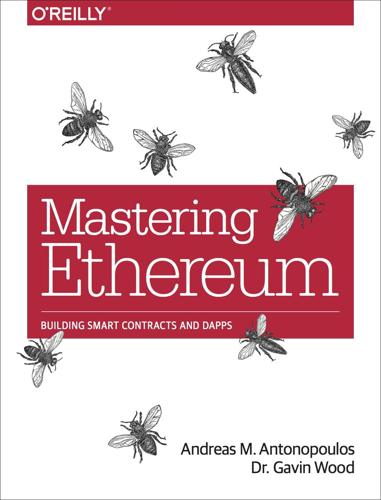
Mastering Ethereum: Building Smart Contracts and DApps
by
Andreas M. Antonopoulos
and
Gavin Wood Ph. D.
Published 23 Dec 2018
Ethereum programs run “everywhere,” yet produce a common state that is secured by the rules of consensus. Turing Completeness as a “Feature” Hearing that Ethereum is Turing complete, you might arrive at the conclusion that this is a feature that is somehow lacking in a system that is Turing incomplete. Rather, it is the opposite. Turing completeness is very easy to achieve; in fact, the simplest Turing-complete state machine known has 4 states and uses 6 symbols, with a state definition that is only 22 instructions long. Indeed, sometimes systems are found to be “accidentally Turing complete.” A fun reference of such systems can be found at http://bit.ly/2Og1VgX.
…
Town Crier, Data Authentication transaction call, Transaction/message call context transaction fees (see gas) transaction receipt, Events transactions, Transactions-Conclusionsas atomic, Life Cycle of a Smart Contract basic structure, The Structure of a Transaction contract creation, Special Transaction: Contract Creation-Special Transaction: Contract Creation defined, Quick Glossary digital signatures and, Digital Signatures-Raw Transaction Creation with EIP-155 gas, Transaction Gas-Transaction Gas multiple-signature, Multiple-Signature (Multisig) Transactions nonces, The Transaction Nonce-Concurrency, Transaction Origination, and Nonces propagation of, Transaction Propagation raw transaction creation with EIP-1455, Raw Transaction Creation with EIP-155 raw transaction creation/signing, Raw Transaction Creation and Signing recipient of, Transaction Recipient recording on the blockchain, Recording on the Blockchain separating signing and transmission, Separating Signing and Transmission (Offline Signing)-Separating Signing and Transmission (Offline Signing) signature prefix value (v) and public key recovery, The Signature Prefix Value (v) and Public Key Recovery signing in practice, Transaction Signing in Practice smart contracts and, Life Cycle of a Smart Contract transmitting data payload to EOAs and contracts, Transmitting a Data Payload to an EOA or Contract-Transmitting a Data Payload to an EOA or Contract transmitting value to EOAs and contract, Transmitting Value to EOAs and Contracts value and data fields, Transaction Value and Data-Transmitting a Data Payload to an EOA or Contract warnings and cautions, Ethereum Addresses and Transactions in this Book transfer functionERC20 token standard, ERC20 workflows: “transfer” and “approve & transferFrom”-ERC20 workflows: “transfer” and “approve & transferFrom” to reduce reentrancy vulnerabilities, Preventative Techniques trapdoor functions, Public Key Cryptography and Cryptocurrency tree structure, navigating, Navigating the HD wallet tree structure TrueBit, Computation Oracles Truffle, Truffle-Using the Truffle consoleas test framework, Testing Smart Contracts configuring, Configuring truffle console, Using the Truffle console-Using the Truffle console contract deployment with, Using truffle to deploy a contract creating a project directory, Creating a truffle project directory-Creating a truffle project directory defined, Quick Glossary installing, Installing the Truffle framework integrating a prebuilt Truffle project, Integrating a prebuilt Truffle project (Truffle Box) interacting with METoken via Truffle console, Interacting with METoken using the Truffle console-Interacting with METoken using the Truffle console migrations, Truffle migrations — understanding deployment scripts-Truffle migrations — understanding deployment scripts running test transaction with, Catching events Truffle Box, Integrating a prebuilt Truffle project (Truffle Box) Trust Wallet, Mobile (Smartphone) Wallets trusted execution environments (TEEs), Data Authentication trustless systems, Oracles(see also oracles) Turing completenessas feature, Turing Completeness as a “Feature” defined, Quick Glossary Ethereum and, Ethereum and Turing Completeness EVM and, What Is the EVM?, Turing Completeness and Gas implications of, Implications of Turing Completeness Turing, Alan, Ethereum and Turing Completeness tx object, Transaction context tx.origin authentication security threatpreventative techniques, Preventative Techniques vulnerability, The Vulnerability typecasting, Variable Typecasting typographical conventions, Conventions Used in This Book U unchecked CALL return value security threat, Unchecked CALL Return Values-Real-World Example: Etherpot and King of the Etherpreventative techniques, Preventative Techniques real-world example: Etherpot and King of the Ether, Real-World Example: Etherpot and King of the Ether vulnerability, The Vulnerability underflow, Arithmetic Over/Underflows-Real-World Examples: PoWHC and Batch Transfer Overflow (CVE-2018–10299), The Vulnerability unexpected etherpreventative techniques, Preventative Techniques security threat from, Unexpected Ether-Further Examples vulnerability, The Vulnerability-The Vulnerability uninitialized storage pointers security threat, Uninitialized Storage Pointers-Real-World Examples: OpenAddressLottery and CryptoRoulette Honey Potspreventative techniques, Preventative Techniques real-world examples: OpenAddressLottery and CryptoRoulette honey pots, Real-World Examples: OpenAddressLottery and CryptoRoulette Honey Pots vulnerability, The Vulnerability-The Vulnerability Universal Turing machine (UTM), Ethereum and Turing Completeness user interface, as DApp frontend, Frontend (Web User Interface) utilities, EthereumJS helpeth: A Command-Line Utilitydapp.tools, dapp.tools EthereumJS helpeth, EthereumJS helpeth: A Command-Line Utility SputnikVM, SputnikVM utility currency, ether as, Compared to Bitcoin utility tokensdefined, Using Tokens: Utility or Equity equity tokens disguised as, It’s a Duck!
…
Further Reading The following references provide additional information on the technologies mentioned here: The Ethereum Yellow Paper: https://ethereum.github.io/yellowpaper/paper.pdf The Beige Paper, a rewrite of the Yellow Paper for a broader audience in less formal language: https://github.com/chronaeon/beigepaper ÐΞVp2p network protocol: http://bit.ly/2quAlTE Ethereum Virtual Machine list of resources: http://bit.ly/2PmtjiS LevelDB database (used most often to store the local copy of the blockchain): http://leveldb.org Merkle Patricia trees: https://github.com/ethereum/wiki/wiki/Patricia-Tree Ethash PoW algorithm: https://github.com/ethereum/wiki/wiki/Ethash Casper PoS v1 Implementation Guide: http://bit.ly/2DyPr3l Go-Ethereum (Geth) client: https://geth.ethereum.org/ Parity Ethereum client: https://parity.io/ Ethereum and Turing Completeness As soon as you start reading about Ethereum, you will immediately encounter the term “Turing complete.” Ethereum, they say, unlike Bitcoin, is Turing complete. What exactly does that mean? The term refers to English mathematician Alan Turing, who is considered the father of computer science. In 1936 he created a mathematical model of a computer consisting of a state machine that manipulates symbols by reading and writing them on sequential memory (resembling an infinite-length paper tape).

Blockchain: Blueprint for a New Economy
by
Melanie Swan
Published 22 Jan 2014
This has been fine for the Blockchain 1.0 implementation of currency and payment transactions, but for the more complicated tier of Blockchain 2.0 applications such as the recording and transfer of more complex assets like smart property and smart contracts, we need the third step—a more robust scripting system—and ultimately, Turing completeness (the ability to run any coin, protocol, or blockchain). Nakamoto envisioned not just sending money from point A to point B, but having programmable money and a full feature set to enable it. One blockchain infrastructure project aiming to deliver a Turing-complete scripting language and Turing-complete platform is Ethereum. Ethereum is a platform and a programming language for building and publishing distributed applications. More fundamentally, Ethereum is a foundational general-purpose cryptocurrency platform that is a Turing-complete virtual machine (meaning that it can run any coin, script, or cryptocurrency project).
…
-M2M/IoT Bitcoin Payment Network to Enable the Machine Economy and consensus models, Blockchain AI: Consensus as the Mechanism to Foster “Friendly” AI-Blockchain Consensus Increases the Information Resolution of the Universe extensibility of, Extensibility of Blockchain Technology Concepts for facilitating big data predictive task automation, Blockchain Layer Could Facilitate Big Data’s Predictive Task Automation future applications, Blockchain AI: Consensus as the Mechanism to Foster “Friendly” AI-Blockchain Consensus Increases the Information Resolution of the Universe limitations of (see limitations) organizational capabilities, Blockchain Technology Is a New and Highly Effective Model for Organizing Activity tracking capabilities, Fundamental Economic Principles: Discovery, Value Attribution, and Exchange-Fundamental Economic Principles: Discovery, Value Attribution, and Exchange blockchain-recorded marriage, Decentralized Governance Services BlockCypher, Blockchain Development Platforms and APIs BOINC, DAOs and DACs bond deposit postings, Technical Challenges Brin, David, Freedom of Speech/Anti-Censorship Applications: Alexandria and Ostel BTCjam, Financial Services business model challenges, Business Model Challenges Buttercoin, Financial Services Byrne, Patrick, Financial Services C Campus Cryptocurrency Network, Campuscoin Campuscoin, Campuscoin-Campuscoin censorship, Internet (see decentralized DNS system) Chain, Blockchain Development Platforms and APIs challenges (see see limitations) charity donations, Charity Donations and the Blockchain—Sean’s Outpost China, Relation to Fiat Currency ChromaWallet, Wallet Development Projects Chronobit, Virtual Notary, Bitnotar, and Chronobit Circle Internet Financial, eWallet Services and Personal Cryptosecurity Codius, Financial Services coin drops, Coin Drops as a Strategy for Public Adoption coin mixing, eWallet Services and Personal Cryptosecurity coin, defining, Terminology and Concepts, Currency, Token, Tokenizing Coinapult, Global Public Health: Bitcoin for Contagious Disease Relief Coinapult LOCKS, Relation to Fiat Currency Coinbase, Merchant Acceptance of Bitcoin, Financial Services CoinBeyond, Merchant Acceptance of Bitcoin Coinffeine, Financial Services Coinify, Merchant Acceptance of Bitcoin Coinprism, Wallet Development Projects Coinspace, Crowdfunding CoinSpark, Wallet Development Projects colored coins, Smart Property, Blockchain 2.0 Protocol Projects community supercomputing, Community Supercomputing Communitycoin, Currency, Token, Tokenizing-Communitycoin: Hayek’s Private Currencies Vie for Attention complementary currency systems, Demurrage Currencies: Potentially Incitory and Redistributable concepts, redefining, Terminology and Concepts-Terminology and Concepts consensus models, Blockchain AI: Consensus as the Mechanism to Foster “Friendly” AI-Blockchain Consensus Increases the Information Resolution of the Universe consensus-derived information, Blockchain Consensus Increases the Information Resolution of the Universe contagious disease relief, Global Public Health: Bitcoin for Contagious Disease Relief contracts, Blockchain 2.0: Contracts-The Blockchain as a Path to Artificial Intelligence (see also smart contracts) crowdfunding, Crowdfunding-Crowdfunding financial services, Financial Services-Financial Services marriage, Decentralized Governance Services prediction markets, Bitcoin Prediction Markets smart property, Smart Property-Smart Property wallet development projects, Wallet Development Projects copyright protection, Monegraph: Online Graphics Protection Counterparty, Blockchain 2.0 Protocol Projects, Counterparty Re-creates Ethereum’s Smart Contract Platform Counterparty currency (XCP), Currency, Token, Tokenizing Counterwallet, Wallet Development Projects crowdfunding, Crowdfunding-Crowdfunding cryptocurrencies benefits of, Currency, Token, Tokenizing cryptosecurity, eWallet Services and Personal Cryptosecurity eWallet services, eWallet Services and Personal Cryptosecurity mechanics of, How a Cryptocurrency Works-Merchant Acceptance of Bitcoin merchant acceptance, Merchant Acceptance of Bitcoin cryptosecurity challenges, eWallet Services and Personal Cryptosecurity cryptowallet, Blockchain Neutrality currency, Technology Stack: Blockchain, Protocol, Currency-Regulatory Status, Currency, Token, Tokenizing-Extensibility of Demurrage Concept and Features Campuscoin, Campuscoin-Campuscoin coin drops, Coin Drops as a Strategy for Public Adoption Communitycoin, Communitycoin: Hayek’s Private Currencies Vie for Attention-Communitycoin: Hayek’s Private Currencies Vie for Attention cryptocurrencies, How a Cryptocurrency Works-Merchant Acceptance of Bitcoin decentralizing, Communitycoin: Hayek’s Private Currencies Vie for Attention defining, Currency, Token, Tokenizing-Currency, Token, Tokenizing, Currency: New Meanings demurrage, Demurrage Currencies: Potentially Incitory and Redistributable-Extensibility of Demurrage Concept and Features double-spend problem, The Double-Spend and Byzantine Generals’ Computing Problems fiat currency, Relation to Fiat Currency-Relation to Fiat Currency monetary and nonmonetary, Currency Multiplicity: Monetary and Nonmonetary Currencies-Currency Multiplicity: Monetary and Nonmonetary Currencies new meanings, Currency: New Meanings technology stack, Technology Stack: Blockchain, Protocol, Currency-Technology Stack: Blockchain, Protocol, Currency currency mulitplicity, Currency Multiplicity: Monetary and Nonmonetary Currencies-Currency Multiplicity: Monetary and Nonmonetary Currencies D DAOs, DAOs and DACs-DAOs and DACs DAOs/DACs, DAOs and DACs-DAOs and DACs, Batched Notary Chains as a Class of Blockchain Infrastructure, Blockchain Government Dapps, Dapps-Dapps, Extensibility of Demurrage Concept and Features Dark Coin, eWallet Services and Personal Cryptosecurity dark pools, Technical Challenges Dark Wallet, eWallet Services and Personal Cryptosecurity DASs, DASs and Self-Bootstrapped Organizations DDP, Crowdfunding decentralization, Smart Contracts, Centralization-Decentralization Tension and Equilibrium decentralized applications (Dapps), Dapps-Dapps decentralized autonomous organization/corporation (DAO) (see DAOs/DACs) decentralized autonomous societies (DASs), DASs and Self-Bootstrapped Organizations decentralized autonomy, eWallet Services and Personal Cryptosecurity decentralized DNS, Namecoin: Decentralized Domain Name System-Decentralized DNS Functionality Beyond Free Speech: Digital Identity challenges of, Challenges and Other Decentralized DNS Services and digital identity, Decentralized DNS Functionality Beyond Free Speech: Digital Identity-Decentralized DNS Functionality Beyond Free Speech: Digital Identity DotP2P, Challenges and Other Decentralized DNS Services decentralized file storage, Blockchain Ecosystem: Decentralized Storage, Communication, and Computation decentralized secure file serving, Blockchain Ecosystem: Decentralized Storage, Communication, and Computation deeds, Decentralized Governance Services demurrage currencies, Demurrage Currencies: Potentially Incitory and Redistributable-Extensibility of Demurrage Concept and Features action-incitory features, Extensibility of Demurrage Concept and Features limitations of, Demurrage Currencies: Potentially Incitory and Redistributable digital art, Digital Art: Blockchain Attestation Services (Notary, Intellectual Property Protection)-Personal Thinking Blockchains (see also blockchain attestation services) hashing and timestamping, Hashing Plus Timestamping-Limitations online graphics protection, Monegraph: Online Graphics Protection digital cryptography, Ethereum: Turing-Complete Virtual Machine, Public/Private-Key Cryptography 101 digital divide, defining, Digital Divide of Bitcoin digital identity verification, Blockchain 2.0: Contracts, Smart Property, Wallet Development Projects, Digital Identity Verification-Digital Divide of Bitcoin, Limitations, Decentralized Governance Services, Liquid Democracy and Random-Sample Elections, Blockchain Learning: Bitcoin MOOCs and Smart Contract Literacy, Privacy Challenges for Personal Records dispute resolution, PrecedentCoin: Blockchain Dispute Resolution DIYweathermodeling, Community Supercomputing DNAnexus, Genomecoin, GenomicResearchcoin Dogecoin, Technology Stack: Blockchain, Protocol, Currency, Currency Multiplicity: Monetary and Nonmonetary Currencies, Scandals and Public Perception DotP2P, Challenges and Other Decentralized DNS Services double-spend problem, The Double-Spend and Byzantine Generals’ Computing Problems DriveShare, DAOs and DACs dynamic redistribution of currency (see demurrage currency) E education (see learning and literacy) Electronic Freedom Foundation (EFF), Distributed Censorship-Resistant Organizational Models EMR (electronic medical record) system, EMRs on the Blockchain: Personal Health Record Storage Ethereum, Crowdfunding, Blockchain 2.0 Protocol Projects, Blockchain Ecosystem: Decentralized Storage, Communication, and Computation, Ethereum: Turing-Complete Virtual Machine-Counterparty Re-creates Ethereum’s Smart Contract Platform eWallet services, eWallet Services and Personal Cryptosecurity ExperimentalResultscoin, Blockchain Academic Publishing: Journalcoin F Fairlay, Bitcoin Prediction Markets fiat currency, Relation to Fiat Currency-Relation to Fiat Currency file serving, Blockchain Ecosystem: Decentralized Storage, Communication, and Computation, Ethereum: Turing-Complete Virtual Machine file storage, Blockchain Ecosystem: Decentralized Storage, Communication, and Computation financial services, Regulatory Status, Financial Services-Financial Services, Blockchain Technology Is a New and Highly Effective Model for Organizing Activity, Government Regulation Fitbit, Personal Thinking Blockchains, Blockchain Health Research Commons, Extensibility of Demurrage Concept and Features Florincoin, Freedom of Speech/Anti-Censorship Applications: Alexandria and Ostel Folding@Home, DAOs and DACs, Blockchain Science: Gridcoin, Foldingcoin, Community Supercomputing franculates, Blockchain Government freedom of speech, Namecoin: Decentralized Domain Name System, Freedom of Speech/Anti-Censorship Applications: Alexandria and Ostel (see also decentralized DNS system) Freicoin, Demurrage Currencies: Potentially Incitory and Redistributable fundraising (see crowdfunding) futarchy, Futarchy: Two-Step Democracy with Voting + Prediction Markets-Futarchy: Two-Step Democracy with Voting + Prediction Markets G GBIcoin, Demurrage Currencies: Potentially Incitory and Redistributable GBIs (Guaranteed Basic Income initiatives), Demurrage Currencies: Potentially Incitory and Redistributable Gems, Blockchain Development Platforms and APIs, Dapps Genecoin, Blockchain Genomics Genomecoin, Genomecoin, GenomicResearchcoin Genomic Data Commons, Genomecoin, GenomicResearchcoin genomic sequencing, Blockchain Genomics 2.0: Industrialized All-Human-Scale Sequencing Solution-Genomecoin, GenomicResearchcoin GenomicResearchcoin, Genomecoin, GenomicResearchcoin genomics, consumer, Blockchain Genomics-Genomecoin, GenomicResearchcoin Git, Blockchain Ecosystem: Decentralized Storage, Communication, and Computation GitHub, Blockchain Academic Publishing: Journalcoin, Currency Multiplicity: Monetary and Nonmonetary Currencies global public health, Global Public Health: Bitcoin for Contagious Disease Relief GoCoin, Financial Services GoToLunchcoin, Terminology and Concepts governance, Blockchain Government-Societal Maturity Impact of Blockchain Governance decentralized services, Decentralized Governance Services-Decentralized Governance Services dispute resolution, PrecedentCoin: Blockchain Dispute Resolution futarchy, Futarchy: Two-Step Democracy with Voting + Prediction Markets-Futarchy: Two-Step Democracy with Voting + Prediction Markets Liquid Democracy system, Liquid Democracy and Random-Sample Elections-Liquid Democracy and Random-Sample Elections personalized governance services, Blockchain Government random-sample elections, Random-Sample Elections societal maturity impact of blockchain governance, Societal Maturity Impact of Blockchain Governance government regulation, Regulatory Status, Government Regulation-Government Regulation Gridcoin, Blockchain Science: Gridcoin, Foldingcoin-Blockchain Science: Gridcoin, Foldingcoin H hashing, Hashing Plus Timestamping-Limitations, Batched Notary Chains as a Class of Blockchain Infrastructure, Technical Challenges Hayek, Friedrich, Communitycoin: Hayek’s Private Currencies Vie for Attention, Demurrage Currencies: Potentially Incitory and Redistributable, Conclusion, The Blockchain Is an Information Technology health, Blockchain Health-Virus Bank, Seed Vault Backup as demurrage currency, Extensibility of Demurrage Concept and Features doctor vendor RFP services, Doctor Vendor RFP Services and Assurance Contracts health notary services, Blockchain Health Notary health research commons , Blockchain Health Research Commons health spending, Healthcoin healthcare decision making and advocacy, Liquid Democracy and Random-Sample Elections personal health record storage, EMRs on the Blockchain: Personal Health Record Storage virus bank and seed vault backup, Virus Bank, Seed Vault Backup Healthcoin, Healthcoin, Demurrage Currencies: Potentially Incitory and Redistributable I identity authentication, eWallet Services and Personal Cryptosecurity, Blockchain 2.0: Contracts, Smart Property, Smart Property, Wallet Development Projects, Digital Identity Verification-Digital Divide of Bitcoin, Limitations, Decentralized Governance Services, Liquid Democracy and Random-Sample Elections, Blockchain Learning: Bitcoin MOOCs and Smart Contract Literacy, Privacy Challenges for Personal Records Indiegogo, Crowdfunding, Dapps industry scandals, Scandals and Public Perception infrastructure needs and issues, Technical Challenges inheritance gifts, Smart Contracts intellectual property, Monegraph: Online Graphics Protection (see also digital art) Internet administration, Distributed Censorship-Resistant Organizational Models Internet Archive, Blockchain Ecosystem: Decentralized Storage, Communication, and Computation, Personal Thinking Blockchains Internet censorship prevention (see Decentralized DNS system) Intuit Quickbooks, Merchant Acceptance of Bitcoin IP protection, Hashing Plus Timestamping IPFS project, Blockchain Ecosystem: Decentralized Storage, Communication, and Computation J Johnston, David, Blockchain Technology Could Be Used in the Administration of All Quanta Journalcoin, Blockchain Academic Publishing: Journalcoin Judobaby, Crowdfunding justice applications for censorship-resistant organizational models, Distributed Censorship-Resistant Organizational Models-Distributed Censorship-Resistant Organizational Models digital art, Digital Art: Blockchain Attestation Services (Notary, Intellectual Property Protection)-Personal Thinking Blockchains (see also digital art, blockchain attestation services) digital identity verification, Blockchain 2.0: Contracts, Smart Property, Wallet Development Projects, Digital Identity Verification-Digital Divide of Bitcoin, Limitations, Decentralized Governance Services, Liquid Democracy and Random-Sample Elections, Blockchain Learning: Bitcoin MOOCs and Smart Contract Literacy, Privacy Challenges for Personal Records freedom of speech/anti-censorship, Freedom of Speech/Anti-Censorship Applications: Alexandria and Ostel governance, Blockchain Government-Societal Maturity Impact of Blockchain Governance (see also governance) Namecoin, Namecoin: Decentralized Domain Name System-Decentralized DNS Functionality Beyond Free Speech: Digital Identity, Monegraph: Online Graphics Protection (see also decentralized DNS) K Kickstarter, Crowdfunding, Community Supercomputing Kipochi, Blockchain Neutrality, Global Public Health: Bitcoin for Contagious Disease Relief, Blockchain Learning: Bitcoin MOOCs and Smart Contract Literacy Koinify, Crowdfunding, Dapps Kraken, Financial Services L latency, Blockchain 2.0 Protocol Projects, Technical Challenges, Technical Challenges, Scandals and Public Perception LaZooz, Dapps, Campuscoin, Extensibility of Demurrage Concept and Features Learncoin, Learncoin learning and literacy, Blockchain Learning: Bitcoin MOOCs and Smart Contract Literacy-Learning Contract Exchanges learning contract exchanges, Learning Contract Exchanges Ledra Capital, Blockchain 2.0: Contracts, Ledra Capital Mega Master Blockchain List legal implications crowdfunding, Crowdfunding smart contracts, Smart Contracts lending, trustless, Smart Property Lighthouse, Crowdfunding limitations, Limitations-Overall: Decentralization Trends Likely to Persist business model challenges, Business Model Challenges government regulation, Government Regulation-Government Regulation personal records privacy challenges, Privacy Challenges for Personal Records scandals and public perception, Scandals and Public Perception-Scandals and Public Perception technical challenges, Technical Challenges-Technical Challenges Liquid Democracy system, Liquid Democracy and Random-Sample Elections-Liquid Democracy and Random-Sample Elections Litecoin, Technology Stack: Blockchain, Protocol, Currency, Technology Stack: Blockchain, Protocol, Currency, Freedom of Speech/Anti-Censorship Applications: Alexandria and Ostel, Currency Multiplicity: Monetary and Nonmonetary Currencies, Technical Challenges literacy (see learning and literacy) LTBcoin, Wallet Development Projects, Currency, Token, Tokenizing M M2M/IoT infrastructure, M2M/IoT Bitcoin Payment Network to Enable the Machine Economy, Blockchain Development Platforms and APIs, Blockchain Academic Publishing: Journalcoin-The Blockchain Is Not for Every Situation, The Blockchain Is an Information Technology Maidsafe, Blockchain Ecosystem: Decentralized Storage, Communication, and Computation, Technical Challenges Manna, Crowdfunding marriage, blockchain recorded, Decentralized Governance Services Mastercoin, Blockchain 2.0 Protocol Projects mechanics of cryptocurrencies, How a Cryptocurrency Works Medici, Financial Services mega master blockchain list, Ledra Capital Mega Master Blockchain List-Ledra Capital Mega Master Blockchain List Melotic, Crowdfunding, Wallet Development Projects merchant acceptance, Merchant Acceptance of Bitcoin merchant payment fees, Summary: Blockchain 1.0 in Practical Use messaging, Ethereum: Turing-Complete Virtual Machine, Dapps, Challenges and Other Decentralized DNS Services, Technical Challenges MetaDisk, DAOs and DACs mindfiles, Personal Thinking Blockchains MIT Bitcoin Project, Campuscoin Monegraph, Monegraph: Online Graphics Protection money (see currency) MOOCs (massive open online courses), Blockchain Learning: Bitcoin MOOCs and Smart Contract Literacy Moroz, Tatiana, Communitycoin: Hayek’s Private Currencies Vie for Attention multicurrency systems, Demurrage Currencies: Potentially Incitory and Redistributable N Nakamoto, Satoshi, Blockchain 2.0: Contracts, Blockchain 2.0: Contracts Namecoin, Namecoin: Decentralized Domain Name System-Decentralized DNS Functionality Beyond Free Speech: Digital Identity, Monegraph: Online Graphics Protection Nationcoin, Coin Drops as a Strategy for Public Adoption, Demurrage Currencies: Potentially Incitory and Redistributable notary chains, Batched Notary Chains as a Class of Blockchain Infrastructure notary services, Hashing Plus Timestamping, Blockchain Health Notary NSA surveillance, Freedom of Speech/Anti-Censorship Applications: Alexandria and Ostel NXT, Technology Stack: Blockchain, Protocol, Currency, Blockchain 2.0 Protocol Projects O offline wallets, Technical Challenges OneName, Digital Identity Verification-Digital Identity Verification OneWallet, Wallet Development Projects online graphics protection, Monegraph: Online Graphics Protection-Monegraph: Online Graphics Protection Open Assets, Blockchain 2.0 Protocol Projects Open Transactions, Blockchain 2.0 Protocol Projects OpenBazaar, Dapps, Government Regulation Ostel, Freedom of Speech/Anti-Censorship Applications: Alexandria and Ostel P passports, Decentralized Governance Services PayPal, The Double-Spend and Byzantine Generals’ Computing Problems, Financial Services, Distributed Censorship-Resistant Organizational Models peer-to-peer lending, Financial Services Peercoin, Technology Stack: Blockchain, Protocol, Currency personal cryptosecurity, eWallet Services and Personal Cryptosecurity personal data rights, Blockchain Genomics personal mindfile blockchains, Personal Thinking Blockchains personal thinking chains, Personal Thinking Blockchains-Personal Thinking Blockchains physical asset keys, Blockchain 2.0: Contracts, Smart Property plagiarism detection/avoidance, Blockchain Academic Publishing: Journalcoin Precedent, PrecedentCoin: Blockchain Dispute Resolution, Terminology and Concepts prediction markets, Bitcoin Prediction Markets, DASs and Self-Bootstrapped Organizations, Decentralized Governance Services, Futarchy: Two-Step Democracy with Voting + Prediction Markets-Futarchy: Two-Step Democracy with Voting + Prediction Markets Predictious, Bitcoin Prediction Markets predictive task automation, Blockchain Layer Could Facilitate Big Data’s Predictive Task Automation privacy challenges, Privacy Challenges for Personal Records private key, eWallet Services and Personal Cryptosecurity Proof of Existence, Proof of Existence-Proof of Existence proof of stake, Blockchain 2.0 Protocol Projects, PrecedentCoin: Blockchain Dispute Resolution, Technical Challenges proof of work, PrecedentCoin: Blockchain Dispute Resolution, Technical Challenges-Technical Challenges property ownership, Smart Property property registration, Decentralized Governance Services public documents registries, Decentralized Governance Services public health, Blockchain Ecosystem: Decentralized Storage, Communication, and Computation, Global Public Health: Bitcoin for Contagious Disease Relief public perception, Scandals and Public Perception-Scandals and Public Perception public/private key cryptography, Public/Private-Key Cryptography 101-Public/Private-Key Cryptography 101 publishing, academic, Blockchain Academic Publishing: Journalcoin-Blockchain Academic Publishing: Journalcoin pull technology, eWallet Services and Personal Cryptosecurity push technology, eWallet Services and Personal Cryptosecurity R random-sample elections, Random-Sample Elections Realcoin, Relation to Fiat Currency redistribution of currency (see demurrage currency) regulation, Government Regulation-Government Regulation regulatory status, Regulatory Status reputation vouching, Ethereum: Turing-Complete Virtual Machine Researchcoin, Blockchain Academic Publishing: Journalcoin REST APIs, Technical Challenges Ripple, Technology Stack: Blockchain, Protocol, Currency, Relation to Fiat Currency, Blockchain 2.0 Protocol Projects Ripple Labs, Financial Services Roadcoin, Blockchain Government S Saldo.mx, Blockchain Neutrality scandals, Scandals and Public Perception science, Blockchain Science: Gridcoin, Foldingcoin-Charity Donations and the Blockchain—Sean’s Outpost community supercomputing, Community Supercomputing global public health, Global Public Health: Bitcoin for Contagious Disease Relief Sean's Outpost, Charity Donations and the Blockchain—Sean’s Outpost secret messaging, Ethereum: Turing-Complete Virtual Machine security issues, Technical Challenges self-bootstrapped organizations, DASs and Self-Bootstrapped Organizations self-directing assets, Automatic Markets and Tradenets self-enforced code, Smart Property self-sufficiency, Smart Contracts SETI@home, Blockchain Science: Gridcoin, Foldingcoin, Community Supercomputing size and bandwidth, Technical Challenges smart contracts, Smart Contracts-Smart Contracts, Smart Contract Advocates on Behalf of Digital Intelligence automatic markets and tradenets, Automatic Markets and Tradenets Counterparty, Counterparty Re-creates Ethereum’s Smart Contract Platform DAOs/DACs, DAOs and DACs-DAOs and DACs Dapps, Dapps-Dapps DASs, DASs and Self-Bootstrapped Organizations Ethereum, Ethereum: Turing-Complete Virtual Machine increasingly autonomous, Dapps, DAOs, DACs, and DASs: Increasingly Autonomous Smart Contracts-Automatic Markets and Tradenets smart literacy contracts, Blockchain Learning: Bitcoin MOOCs and Smart Contract Literacy-Learning Contract Exchanges smart property, Smart Property-Smart Property, Monegraph: Online Graphics Protection smartwatch, Extensibility of Demurrage Concept and Features Snowden, Edward, Distributed Censorship-Resistant Organizational Models social contracts, Smart Contracts social network currencies, Currency Multiplicity: Monetary and Nonmonetary Currencies Stellar, Blockchain Development Platforms and APIs stock market, Financial Services Storj, Blockchain Ecosystem: Decentralized Storage, Communication, and Computation, Dapps, Technical Challenges Stripe, Blockchain Development Platforms and APIs supercomputing, Community Supercomputing Svalbard Global Seed Vault, Virus Bank, Seed Vault Backup Swancoin, Smart Property swaps exchange, Financial Services Swarm, Crowdfunding, Dapps Swarm (Ethereum), Ethereum: Turing-Complete Virtual Machine Swarmops, Crowdfunding T Tatianacoin, Communitycoin: Hayek’s Private Currencies Vie for Attention technical challenges, Technical Challenges-Technical Challenges Tendermint, Technical Challenges Tera Exchange, Financial Services terminology, Terminology and Concepts-Terminology and Concepts 37Coins, Global Public Health: Bitcoin for Contagious Disease Relief throughput, Technical Challenges timestamping, Hashing Plus Timestamping-Limitations titling, Decentralized Governance Services tradenets, Automatic Markets and Tradenets transaction fees, Summary: Blockchain 1.0 in Practical Use Tribecoin, Coin Drops as a Strategy for Public Adoption trustless lending, Smart Property Truthcoin, Futarchy: Two-Step Democracy with Voting + Prediction Markets Turing completeness, Ethereum: Turing-Complete Virtual Machine Twister, Dapps Twitter, Monegraph: Online Graphics Protection U Uber, Government Regulation unbanked/underbanked markets, Blockchain Neutrality usability issues, Technical Challenges V value chain composition, How a Cryptocurrency Works versioning issues, Technical Challenges Virtual Notary, Virtual Notary, Bitnotar, and Chronobit voting and prediction, Futarchy: Two-Step Democracy with Voting + Prediction Markets-Futarchy: Two-Step Democracy with Voting + Prediction Markets W wallet APIs, Blockchain Development Platforms and APIs wallet companies, Wallet Development Projects wallet software, How a Cryptocurrency Works wasted resources, Technical Challenges Wayback Machine, Blockchain Ecosystem: Decentralized Storage, Communication, and Computation Wedbush Securities, Financial Services Whatevercoin, Terminology and Concepts WikiLeaks, Distributed Censorship-Resistant Organizational Models Wikinomics, Community Supercomputing World Citizen project, Decentralized Governance Services X Xapo, eWallet Services and Personal Cryptosecurity Z Zennet Supercomputer, Community Supercomputing Zooko's Triangle, Decentralized DNS Functionality Beyond Free Speech: Digital Identity About the Author Melanie Swan is the Founder of the Institute for Blockchain Studies and a Contemporary Philosophy MA candidate at Kingston University London and Université Paris VIII.
…
-M2M/IoT Bitcoin Payment Network to Enable the Machine Economy and consensus models, Blockchain AI: Consensus as the Mechanism to Foster “Friendly” AI-Blockchain Consensus Increases the Information Resolution of the Universe extensibility of, Extensibility of Blockchain Technology Concepts for facilitating big data predictive task automation, Blockchain Layer Could Facilitate Big Data’s Predictive Task Automation future applications, Blockchain AI: Consensus as the Mechanism to Foster “Friendly” AI-Blockchain Consensus Increases the Information Resolution of the Universe limitations of (see limitations) organizational capabilities, Blockchain Technology Is a New and Highly Effective Model for Organizing Activity tracking capabilities, Fundamental Economic Principles: Discovery, Value Attribution, and Exchange-Fundamental Economic Principles: Discovery, Value Attribution, and Exchange blockchain-recorded marriage, Decentralized Governance Services BlockCypher, Blockchain Development Platforms and APIs BOINC, DAOs and DACs bond deposit postings, Technical Challenges Brin, David, Freedom of Speech/Anti-Censorship Applications: Alexandria and Ostel BTCjam, Financial Services business model challenges, Business Model Challenges Buttercoin, Financial Services Byrne, Patrick, Financial Services C Campus Cryptocurrency Network, Campuscoin Campuscoin, Campuscoin-Campuscoin censorship, Internet (see decentralized DNS system) Chain, Blockchain Development Platforms and APIs challenges (see see limitations) charity donations, Charity Donations and the Blockchain—Sean’s Outpost China, Relation to Fiat Currency ChromaWallet, Wallet Development Projects Chronobit, Virtual Notary, Bitnotar, and Chronobit Circle Internet Financial, eWallet Services and Personal Cryptosecurity Codius, Financial Services coin drops, Coin Drops as a Strategy for Public Adoption coin mixing, eWallet Services and Personal Cryptosecurity coin, defining, Terminology and Concepts, Currency, Token, Tokenizing Coinapult, Global Public Health: Bitcoin for Contagious Disease Relief Coinapult LOCKS, Relation to Fiat Currency Coinbase, Merchant Acceptance of Bitcoin, Financial Services CoinBeyond, Merchant Acceptance of Bitcoin Coinffeine, Financial Services Coinify, Merchant Acceptance of Bitcoin Coinprism, Wallet Development Projects Coinspace, Crowdfunding CoinSpark, Wallet Development Projects colored coins, Smart Property, Blockchain 2.0 Protocol Projects community supercomputing, Community Supercomputing Communitycoin, Currency, Token, Tokenizing-Communitycoin: Hayek’s Private Currencies Vie for Attention complementary currency systems, Demurrage Currencies: Potentially Incitory and Redistributable concepts, redefining, Terminology and Concepts-Terminology and Concepts consensus models, Blockchain AI: Consensus as the Mechanism to Foster “Friendly” AI-Blockchain Consensus Increases the Information Resolution of the Universe consensus-derived information, Blockchain Consensus Increases the Information Resolution of the Universe contagious disease relief, Global Public Health: Bitcoin for Contagious Disease Relief contracts, Blockchain 2.0: Contracts-The Blockchain as a Path to Artificial Intelligence (see also smart contracts) crowdfunding, Crowdfunding-Crowdfunding financial services, Financial Services-Financial Services marriage, Decentralized Governance Services prediction markets, Bitcoin Prediction Markets smart property, Smart Property-Smart Property wallet development projects, Wallet Development Projects copyright protection, Monegraph: Online Graphics Protection Counterparty, Blockchain 2.0 Protocol Projects, Counterparty Re-creates Ethereum’s Smart Contract Platform Counterparty currency (XCP), Currency, Token, Tokenizing Counterwallet, Wallet Development Projects crowdfunding, Crowdfunding-Crowdfunding cryptocurrencies benefits of, Currency, Token, Tokenizing cryptosecurity, eWallet Services and Personal Cryptosecurity eWallet services, eWallet Services and Personal Cryptosecurity mechanics of, How a Cryptocurrency Works-Merchant Acceptance of Bitcoin merchant acceptance, Merchant Acceptance of Bitcoin cryptosecurity challenges, eWallet Services and Personal Cryptosecurity cryptowallet, Blockchain Neutrality currency, Technology Stack: Blockchain, Protocol, Currency-Regulatory Status, Currency, Token, Tokenizing-Extensibility of Demurrage Concept and Features Campuscoin, Campuscoin-Campuscoin coin drops, Coin Drops as a Strategy for Public Adoption Communitycoin, Communitycoin: Hayek’s Private Currencies Vie for Attention-Communitycoin: Hayek’s Private Currencies Vie for Attention cryptocurrencies, How a Cryptocurrency Works-Merchant Acceptance of Bitcoin decentralizing, Communitycoin: Hayek’s Private Currencies Vie for Attention defining, Currency, Token, Tokenizing-Currency, Token, Tokenizing, Currency: New Meanings demurrage, Demurrage Currencies: Potentially Incitory and Redistributable-Extensibility of Demurrage Concept and Features double-spend problem, The Double-Spend and Byzantine Generals’ Computing Problems fiat currency, Relation to Fiat Currency-Relation to Fiat Currency monetary and nonmonetary, Currency Multiplicity: Monetary and Nonmonetary Currencies-Currency Multiplicity: Monetary and Nonmonetary Currencies new meanings, Currency: New Meanings technology stack, Technology Stack: Blockchain, Protocol, Currency-Technology Stack: Blockchain, Protocol, Currency currency mulitplicity, Currency Multiplicity: Monetary and Nonmonetary Currencies-Currency Multiplicity: Monetary and Nonmonetary Currencies D DAOs, DAOs and DACs-DAOs and DACs DAOs/DACs, DAOs and DACs-DAOs and DACs, Batched Notary Chains as a Class of Blockchain Infrastructure, Blockchain Government Dapps, Dapps-Dapps, Extensibility of Demurrage Concept and Features Dark Coin, eWallet Services and Personal Cryptosecurity dark pools, Technical Challenges Dark Wallet, eWallet Services and Personal Cryptosecurity DASs, DASs and Self-Bootstrapped Organizations DDP, Crowdfunding decentralization, Smart Contracts, Centralization-Decentralization Tension and Equilibrium decentralized applications (Dapps), Dapps-Dapps decentralized autonomous organization/corporation (DAO) (see DAOs/DACs) decentralized autonomous societies (DASs), DASs and Self-Bootstrapped Organizations decentralized autonomy, eWallet Services and Personal Cryptosecurity decentralized DNS, Namecoin: Decentralized Domain Name System-Decentralized DNS Functionality Beyond Free Speech: Digital Identity challenges of, Challenges and Other Decentralized DNS Services and digital identity, Decentralized DNS Functionality Beyond Free Speech: Digital Identity-Decentralized DNS Functionality Beyond Free Speech: Digital Identity DotP2P, Challenges and Other Decentralized DNS Services decentralized file storage, Blockchain Ecosystem: Decentralized Storage, Communication, and Computation decentralized secure file serving, Blockchain Ecosystem: Decentralized Storage, Communication, and Computation deeds, Decentralized Governance Services demurrage currencies, Demurrage Currencies: Potentially Incitory and Redistributable-Extensibility of Demurrage Concept and Features action-incitory features, Extensibility of Demurrage Concept and Features limitations of, Demurrage Currencies: Potentially Incitory and Redistributable digital art, Digital Art: Blockchain Attestation Services (Notary, Intellectual Property Protection)-Personal Thinking Blockchains (see also blockchain attestation services) hashing and timestamping, Hashing Plus Timestamping-Limitations online graphics protection, Monegraph: Online Graphics Protection digital cryptography, Ethereum: Turing-Complete Virtual Machine, Public/Private-Key Cryptography 101 digital divide, defining, Digital Divide of Bitcoin digital identity verification, Blockchain 2.0: Contracts, Smart Property, Wallet Development Projects, Digital Identity Verification-Digital Divide of Bitcoin, Limitations, Decentralized Governance Services, Liquid Democracy and Random-Sample Elections, Blockchain Learning: Bitcoin MOOCs and Smart Contract Literacy, Privacy Challenges for Personal Records dispute resolution, PrecedentCoin: Blockchain Dispute Resolution DIYweathermodeling, Community Supercomputing DNAnexus, Genomecoin, GenomicResearchcoin Dogecoin, Technology Stack: Blockchain, Protocol, Currency, Currency Multiplicity: Monetary and Nonmonetary Currencies, Scandals and Public Perception DotP2P, Challenges and Other Decentralized DNS Services double-spend problem, The Double-Spend and Byzantine Generals’ Computing Problems DriveShare, DAOs and DACs dynamic redistribution of currency (see demurrage currency) E education (see learning and literacy) Electronic Freedom Foundation (EFF), Distributed Censorship-Resistant Organizational Models EMR (electronic medical record) system, EMRs on the Blockchain: Personal Health Record Storage Ethereum, Crowdfunding, Blockchain 2.0 Protocol Projects, Blockchain Ecosystem: Decentralized Storage, Communication, and Computation, Ethereum: Turing-Complete Virtual Machine-Counterparty Re-creates Ethereum’s Smart Contract Platform eWallet services, eWallet Services and Personal Cryptosecurity ExperimentalResultscoin, Blockchain Academic Publishing: Journalcoin F Fairlay, Bitcoin Prediction Markets fiat currency, Relation to Fiat Currency-Relation to Fiat Currency file serving, Blockchain Ecosystem: Decentralized Storage, Communication, and Computation, Ethereum: Turing-Complete Virtual Machine file storage, Blockchain Ecosystem: Decentralized Storage, Communication, and Computation financial services, Regulatory Status, Financial Services-Financial Services, Blockchain Technology Is a New and Highly Effective Model for Organizing Activity, Government Regulation Fitbit, Personal Thinking Blockchains, Blockchain Health Research Commons, Extensibility of Demurrage Concept and Features Florincoin, Freedom of Speech/Anti-Censorship Applications: Alexandria and Ostel Folding@Home, DAOs and DACs, Blockchain Science: Gridcoin, Foldingcoin, Community Supercomputing franculates, Blockchain Government freedom of speech, Namecoin: Decentralized Domain Name System, Freedom of Speech/Anti-Censorship Applications: Alexandria and Ostel (see also decentralized DNS system) Freicoin, Demurrage Currencies: Potentially Incitory and Redistributable fundraising (see crowdfunding) futarchy, Futarchy: Two-Step Democracy with Voting + Prediction Markets-Futarchy: Two-Step Democracy with Voting + Prediction Markets G GBIcoin, Demurrage Currencies: Potentially Incitory and Redistributable GBIs (Guaranteed Basic Income initiatives), Demurrage Currencies: Potentially Incitory and Redistributable Gems, Blockchain Development Platforms and APIs, Dapps Genecoin, Blockchain Genomics Genomecoin, Genomecoin, GenomicResearchcoin Genomic Data Commons, Genomecoin, GenomicResearchcoin genomic sequencing, Blockchain Genomics 2.0: Industrialized All-Human-Scale Sequencing Solution-Genomecoin, GenomicResearchcoin GenomicResearchcoin, Genomecoin, GenomicResearchcoin genomics, consumer, Blockchain Genomics-Genomecoin, GenomicResearchcoin Git, Blockchain Ecosystem: Decentralized Storage, Communication, and Computation GitHub, Blockchain Academic Publishing: Journalcoin, Currency Multiplicity: Monetary and Nonmonetary Currencies global public health, Global Public Health: Bitcoin for Contagious Disease Relief GoCoin, Financial Services GoToLunchcoin, Terminology and Concepts governance, Blockchain Government-Societal Maturity Impact of Blockchain Governance decentralized services, Decentralized Governance Services-Decentralized Governance Services dispute resolution, PrecedentCoin: Blockchain Dispute Resolution futarchy, Futarchy: Two-Step Democracy with Voting + Prediction Markets-Futarchy: Two-Step Democracy with Voting + Prediction Markets Liquid Democracy system, Liquid Democracy and Random-Sample Elections-Liquid Democracy and Random-Sample Elections personalized governance services, Blockchain Government random-sample elections, Random-Sample Elections societal maturity impact of blockchain governance, Societal Maturity Impact of Blockchain Governance government regulation, Regulatory Status, Government Regulation-Government Regulation Gridcoin, Blockchain Science: Gridcoin, Foldingcoin-Blockchain Science: Gridcoin, Foldingcoin H hashing, Hashing Plus Timestamping-Limitations, Batched Notary Chains as a Class of Blockchain Infrastructure, Technical Challenges Hayek, Friedrich, Communitycoin: Hayek’s Private Currencies Vie for Attention, Demurrage Currencies: Potentially Incitory and Redistributable, Conclusion, The Blockchain Is an Information Technology health, Blockchain Health-Virus Bank, Seed Vault Backup as demurrage currency, Extensibility of Demurrage Concept and Features doctor vendor RFP services, Doctor Vendor RFP Services and Assurance Contracts health notary services, Blockchain Health Notary health research commons , Blockchain Health Research Commons health spending, Healthcoin healthcare decision making and advocacy, Liquid Democracy and Random-Sample Elections personal health record storage, EMRs on the Blockchain: Personal Health Record Storage virus bank and seed vault backup, Virus Bank, Seed Vault Backup Healthcoin, Healthcoin, Demurrage Currencies: Potentially Incitory and Redistributable I identity authentication, eWallet Services and Personal Cryptosecurity, Blockchain 2.0: Contracts, Smart Property, Smart Property, Wallet Development Projects, Digital Identity Verification-Digital Divide of Bitcoin, Limitations, Decentralized Governance Services, Liquid Democracy and Random-Sample Elections, Blockchain Learning: Bitcoin MOOCs and Smart Contract Literacy, Privacy Challenges for Personal Records Indiegogo, Crowdfunding, Dapps industry scandals, Scandals and Public Perception infrastructure needs and issues, Technical Challenges inheritance gifts, Smart Contracts intellectual property, Monegraph: Online Graphics Protection (see also digital art) Internet administration, Distributed Censorship-Resistant Organizational Models Internet Archive, Blockchain Ecosystem: Decentralized Storage, Communication, and Computation, Personal Thinking Blockchains Internet censorship prevention (see Decentralized DNS system) Intuit Quickbooks, Merchant Acceptance of Bitcoin IP protection, Hashing Plus Timestamping IPFS project, Blockchain Ecosystem: Decentralized Storage, Communication, and Computation J Johnston, David, Blockchain Technology Could Be Used in the Administration of All Quanta Journalcoin, Blockchain Academic Publishing: Journalcoin Judobaby, Crowdfunding justice applications for censorship-resistant organizational models, Distributed Censorship-Resistant Organizational Models-Distributed Censorship-Resistant Organizational Models digital art, Digital Art: Blockchain Attestation Services (Notary, Intellectual Property Protection)-Personal Thinking Blockchains (see also digital art, blockchain attestation services) digital identity verification, Blockchain 2.0: Contracts, Smart Property, Wallet Development Projects, Digital Identity Verification-Digital Divide of Bitcoin, Limitations, Decentralized Governance Services, Liquid Democracy and Random-Sample Elections, Blockchain Learning: Bitcoin MOOCs and Smart Contract Literacy, Privacy Challenges for Personal Records freedom of speech/anti-censorship, Freedom of Speech/Anti-Censorship Applications: Alexandria and Ostel governance, Blockchain Government-Societal Maturity Impact of Blockchain Governance (see also governance) Namecoin, Namecoin: Decentralized Domain Name System-Decentralized DNS Functionality Beyond Free Speech: Digital Identity, Monegraph: Online Graphics Protection (see also decentralized DNS) K Kickstarter, Crowdfunding, Community Supercomputing Kipochi, Blockchain Neutrality, Global Public Health: Bitcoin for Contagious Disease Relief, Blockchain Learning: Bitcoin MOOCs and Smart Contract Literacy Koinify, Crowdfunding, Dapps Kraken, Financial Services L latency, Blockchain 2.0 Protocol Projects, Technical Challenges, Technical Challenges, Scandals and Public Perception LaZooz, Dapps, Campuscoin, Extensibility of Demurrage Concept and Features Learncoin, Learncoin learning and literacy, Blockchain Learning: Bitcoin MOOCs and Smart Contract Literacy-Learning Contract Exchanges learning contract exchanges, Learning Contract Exchanges Ledra Capital, Blockchain 2.0: Contracts, Ledra Capital Mega Master Blockchain List legal implications crowdfunding, Crowdfunding smart contracts, Smart Contracts lending, trustless, Smart Property Lighthouse, Crowdfunding limitations, Limitations-Overall: Decentralization Trends Likely to Persist business model challenges, Business Model Challenges government regulation, Government Regulation-Government Regulation personal records privacy challenges, Privacy Challenges for Personal Records scandals and public perception, Scandals and Public Perception-Scandals and Public Perception technical challenges, Technical Challenges-Technical Challenges Liquid Democracy system, Liquid Democracy and Random-Sample Elections-Liquid Democracy and Random-Sample Elections Litecoin, Technology Stack: Blockchain, Protocol, Currency, Technology Stack: Blockchain, Protocol, Currency, Freedom of Speech/Anti-Censorship Applications: Alexandria and Ostel, Currency Multiplicity: Monetary and Nonmonetary Currencies, Technical Challenges literacy (see learning and literacy) LTBcoin, Wallet Development Projects, Currency, Token, Tokenizing M M2M/IoT infrastructure, M2M/IoT Bitcoin Payment Network to Enable the Machine Economy, Blockchain Development Platforms and APIs, Blockchain Academic Publishing: Journalcoin-The Blockchain Is Not for Every Situation, The Blockchain Is an Information Technology Maidsafe, Blockchain Ecosystem: Decentralized Storage, Communication, and Computation, Technical Challenges Manna, Crowdfunding marriage, blockchain recorded, Decentralized Governance Services Mastercoin, Blockchain 2.0 Protocol Projects mechanics of cryptocurrencies, How a Cryptocurrency Works Medici, Financial Services mega master blockchain list, Ledra Capital Mega Master Blockchain List-Ledra Capital Mega Master Blockchain List Melotic, Crowdfunding, Wallet Development Projects merchant acceptance, Merchant Acceptance of Bitcoin merchant payment fees, Summary: Blockchain 1.0 in Practical Use messaging, Ethereum: Turing-Complete Virtual Machine, Dapps, Challenges and Other Decentralized DNS Services, Technical Challenges MetaDisk, DAOs and DACs mindfiles, Personal Thinking Blockchains MIT Bitcoin Project, Campuscoin Monegraph, Monegraph: Online Graphics Protection money (see currency) MOOCs (massive open online courses), Blockchain Learning: Bitcoin MOOCs and Smart Contract Literacy Moroz, Tatiana, Communitycoin: Hayek’s Private Currencies Vie for Attention multicurrency systems, Demurrage Currencies: Potentially Incitory and Redistributable N Nakamoto, Satoshi, Blockchain 2.0: Contracts, Blockchain 2.0: Contracts Namecoin, Namecoin: Decentralized Domain Name System-Decentralized DNS Functionality Beyond Free Speech: Digital Identity, Monegraph: Online Graphics Protection Nationcoin, Coin Drops as a Strategy for Public Adoption, Demurrage Currencies: Potentially Incitory and Redistributable notary chains, Batched Notary Chains as a Class of Blockchain Infrastructure notary services, Hashing Plus Timestamping, Blockchain Health Notary NSA surveillance, Freedom of Speech/Anti-Censorship Applications: Alexandria and Ostel NXT, Technology Stack: Blockchain, Protocol, Currency, Blockchain 2.0 Protocol Projects O offline wallets, Technical Challenges OneName, Digital Identity Verification-Digital Identity Verification OneWallet, Wallet Development Projects online graphics protection, Monegraph: Online Graphics Protection-Monegraph: Online Graphics Protection Open Assets, Blockchain 2.0 Protocol Projects Open Transactions, Blockchain 2.0 Protocol Projects OpenBazaar, Dapps, Government Regulation Ostel, Freedom of Speech/Anti-Censorship Applications: Alexandria and Ostel P passports, Decentralized Governance Services PayPal, The Double-Spend and Byzantine Generals’ Computing Problems, Financial Services, Distributed Censorship-Resistant Organizational Models peer-to-peer lending, Financial Services Peercoin, Technology Stack: Blockchain, Protocol, Currency personal cryptosecurity, eWallet Services and Personal Cryptosecurity personal data rights, Blockchain Genomics personal mindfile blockchains, Personal Thinking Blockchains personal thinking chains, Personal Thinking Blockchains-Personal Thinking Blockchains physical asset keys, Blockchain 2.0: Contracts, Smart Property plagiarism detection/avoidance, Blockchain Academic Publishing: Journalcoin Precedent, PrecedentCoin: Blockchain Dispute Resolution, Terminology and Concepts prediction markets, Bitcoin Prediction Markets, DASs and Self-Bootstrapped Organizations, Decentralized Governance Services, Futarchy: Two-Step Democracy with Voting + Prediction Markets-Futarchy: Two-Step Democracy with Voting + Prediction Markets Predictious, Bitcoin Prediction Markets predictive task automation, Blockchain Layer Could Facilitate Big Data’s Predictive Task Automation privacy challenges, Privacy Challenges for Personal Records private key, eWallet Services and Personal Cryptosecurity Proof of Existence, Proof of Existence-Proof of Existence proof of stake, Blockchain 2.0 Protocol Projects, PrecedentCoin: Blockchain Dispute Resolution, Technical Challenges proof of work, PrecedentCoin: Blockchain Dispute Resolution, Technical Challenges-Technical Challenges property ownership, Smart Property property registration, Decentralized Governance Services public documents registries, Decentralized Governance Services public health, Blockchain Ecosystem: Decentralized Storage, Communication, and Computation, Global Public Health: Bitcoin for Contagious Disease Relief public perception, Scandals and Public Perception-Scandals and Public Perception public/private key cryptography, Public/Private-Key Cryptography 101-Public/Private-Key Cryptography 101 publishing, academic, Blockchain Academic Publishing: Journalcoin-Blockchain Academic Publishing: Journalcoin pull technology, eWallet Services and Personal Cryptosecurity push technology, eWallet Services and Personal Cryptosecurity R random-sample elections, Random-Sample Elections Realcoin, Relation to Fiat Currency redistribution of currency (see demurrage currency) regulation, Government Regulation-Government Regulation regulatory status, Regulatory Status reputation vouching, Ethereum: Turing-Complete Virtual Machine Researchcoin, Blockchain Academic Publishing: Journalcoin REST APIs, Technical Challenges Ripple, Technology Stack: Blockchain, Protocol, Currency, Relation to Fiat Currency, Blockchain 2.0 Protocol Projects Ripple Labs, Financial Services Roadcoin, Blockchain Government S Saldo.mx, Blockchain Neutrality scandals, Scandals and Public Perception science, Blockchain Science: Gridcoin, Foldingcoin-Charity Donations and the Blockchain—Sean’s Outpost community supercomputing, Community Supercomputing global public health, Global Public Health: Bitcoin for Contagious Disease Relief Sean's Outpost, Charity Donations and the Blockchain—Sean’s Outpost secret messaging, Ethereum: Turing-Complete Virtual Machine security issues, Technical Challenges self-bootstrapped organizations, DASs and Self-Bootstrapped Organizations self-directing assets, Automatic Markets and Tradenets self-enforced code, Smart Property self-sufficiency, Smart Contracts SETI@home, Blockchain Science: Gridcoin, Foldingcoin, Community Supercomputing size and bandwidth, Technical Challenges smart contracts, Smart Contracts-Smart Contracts, Smart Contract Advocates on Behalf of Digital Intelligence automatic markets and tradenets, Automatic Markets and Tradenets Counterparty, Counterparty Re-creates Ethereum’s Smart Contract Platform DAOs/DACs, DAOs and DACs-DAOs and DACs Dapps, Dapps-Dapps DASs, DASs and Self-Bootstrapped Organizations Ethereum, Ethereum: Turing-Complete Virtual Machine increasingly autonomous, Dapps, DAOs, DACs, and DASs: Increasingly Autonomous Smart Contracts-Automatic Markets and Tradenets smart literacy contracts, Blockchain Learning: Bitcoin MOOCs and Smart Contract Literacy-Learning Contract Exchanges smart property, Smart Property-Smart Property, Monegraph: Online Graphics Protection smartwatch, Extensibility of Demurrage Concept and Features Snowden, Edward, Distributed Censorship-Resistant Organizational Models social contracts, Smart Contracts social network currencies, Currency Multiplicity: Monetary and Nonmonetary Currencies Stellar, Blockchain Development Platforms and APIs stock market, Financial Services Storj, Blockchain Ecosystem: Decentralized Storage, Communication, and Computation, Dapps, Technical Challenges Stripe, Blockchain Development Platforms and APIs supercomputing, Community Supercomputing Svalbard Global Seed Vault, Virus Bank, Seed Vault Backup Swancoin, Smart Property swaps exchange, Financial Services Swarm, Crowdfunding, Dapps Swarm (Ethereum), Ethereum: Turing-Complete Virtual Machine Swarmops, Crowdfunding T Tatianacoin, Communitycoin: Hayek’s Private Currencies Vie for Attention technical challenges, Technical Challenges-Technical Challenges Tendermint, Technical Challenges Tera Exchange, Financial Services terminology, Terminology and Concepts-Terminology and Concepts 37Coins, Global Public Health: Bitcoin for Contagious Disease Relief throughput, Technical Challenges timestamping, Hashing Plus Timestamping-Limitations titling, Decentralized Governance Services tradenets, Automatic Markets and Tradenets transaction fees, Summary: Blockchain 1.0 in Practical Use Tribecoin, Coin Drops as a Strategy for Public Adoption trustless lending, Smart Property Truthcoin, Futarchy: Two-Step Democracy with Voting + Prediction Markets Turing completeness, Ethereum: Turing-Complete Virtual Machine Twister, Dapps Twitter, Monegraph: Online Graphics Protection U Uber, Government Regulation unbanked/underbanked markets, Blockchain Neutrality usability issues, Technical Challenges V value chain composition, How a Cryptocurrency Works versioning issues, Technical Challenges Virtual Notary, Virtual Notary, Bitnotar, and Chronobit voting and prediction, Futarchy: Two-Step Democracy with Voting + Prediction Markets-Futarchy: Two-Step Democracy with Voting + Prediction Markets W wallet APIs, Blockchain Development Platforms and APIs wallet companies, Wallet Development Projects wallet software, How a Cryptocurrency Works wasted resources, Technical Challenges Wayback Machine, Blockchain Ecosystem: Decentralized Storage, Communication, and Computation Wedbush Securities, Financial Services Whatevercoin, Terminology and Concepts WikiLeaks, Distributed Censorship-Resistant Organizational Models Wikinomics, Community Supercomputing World Citizen project, Decentralized Governance Services X Xapo, eWallet Services and Personal Cryptosecurity Z Zennet Supercomputer, Community Supercomputing Zooko's Triangle, Decentralized DNS Functionality Beyond Free Speech: Digital Identity About the Author Melanie Swan is the Founder of the Institute for Blockchain Studies and a Contemporary Philosophy MA candidate at Kingston University London and Université Paris VIII.

In Our Own Image: Savior or Destroyer? The History and Future of Artificial Intelligence
by
George Zarkadakis
Published 7 Mar 2016
On the basis of this, Turing4 designed an electromechanical device – called ‘bombe’ because of the terrible noise it produced – that could predict some of the daily settings of the Enigma machines by replicating the actions of several Enigma machines wired together. This idea of a machine (the bombe) effectively simulating other machines (the Enigma) is central to computer theory. When a machine can simulate every other machine this is called ‘Turing complete’. We saw how Babbage’s Analytical Engine was the first ‘Turing complete’ machine in the world. Our modern computers are also Turing complete. But to get from the Analytical Engine to modern computers required a giant leap in the early 1940s, as the British and the Americans fought the Germans in the Atlantic. Turing’s bombe cannot be considered a precursor of modern computer architecture.
…
Points on the new patterns will be either 0 or 1 depending on their current value as well as the value of their neighbours. In the early 1980s, the English mathematician Stephen Wolfram conjectured that a particular cellular automaton called ‘Rule 110’ might be ‘Turing complete’,21 a conjecture that was later proved by Matthew Cook. ‘Turing complete’ means that Rule 110 is capable of universal computation, i.e. any calculation or computer program can be simulated using this automaton. What is particularly interesting about Rule 110 is its behaviour on the boundary between stability and chaos. It is neither stable nor completely chaotic.
…
At Home in the Universe: The Search for the Laws of Self-Organization and Complexity. Oxford: Oxford University Press. 20Rebeck, J. (1994), ‘Synthetic Self-Replicating Molecules’, in: Scientific American, July 1994, pp. 48–55. 21Wolfram had conjectured that Rule 110 was Turing complete. Proof that Rule 110 is Turing complete was published by Matthew Cook. The proof is found in: Wolfram, S. (2002), A New Kind of Science, Wolfram Media. 22Or a transition to another state of dynamic equilibrium. In this case we have a ‘bifurcation’ point beyond which the system transits unpredictably to another attractor.

Life After Google: The Fall of Big Data and the Rise of the Blockchain Economy
by
George Gilder
Published 16 Jul 2018
Marching to and fro across stages at Fintech conferences, Wright declares the bitcoin a superior platform for any kind of smart contract or “Turing-complete” thaumaturgy. “Smart contracts,” embodied in rigorous software, were proposed by Nick Szabo in the 1990s along with much of the rest of the bitcoin portfolio. They are self-executing contracts that can ride on an immutable blockchain and bypass lawyers and accountants. But to implement such contracts a computer platform must be fully programmable as a “Turing machine.” With an abstruse discourse on the properties of the Forth programming language, Wright attempts to show that bitcoin is as Turing-complete as any other platform. Szabo curtly disputes that claim, as well as nearly everything else that Wright says.
…
Focusing on security, its “script” language is serviceable but not Turing-complete, lacking recursive loops. So it is limited in its ability to accommodate smart contracts, but limited also in its vulnerability to hacks. Its Lightening extension gives it potential scalability for smaller transactions. Its key figures are Satoshi and Nick Szabo, who foreshadowed it with bit gold. Ethereum, seven years old, is still the most versatile platform for smart contracts and initial coin offerings. Its software language, Solidity, is Turing-complete. Its coin—ether—commands the second-highest market cap among cryptocurrencies.
…
Realizing that “crypto projects were taking up thirty hours per week of my time,” he dropped out of university in April 2013.2 In the Waterloo meeting with Strachman and Gibson, his last chance to get their attention before he transgressed into his over-the-hill twenties, Buterin proposed to revolutionize the Internet and the global financial system. “That’s what Peter Thiel wanted, right?” As he recited a litany of ambitiously cockeyed schemes—“Turing-complete” blockchains, new software languages, currencies, computer platforms, smart contracts—Strachman and Gibson could see that he was a genius. But his grandiosity and apparent lack of focus defied all the rules of successful enterprise. They decided to support him anyway. In November 2013, Buterin wrote the Ethereum white paper, and on June 5, 2014, Peter Thiel announced a new group of twenty Thiel Fellows, which included Buterin.
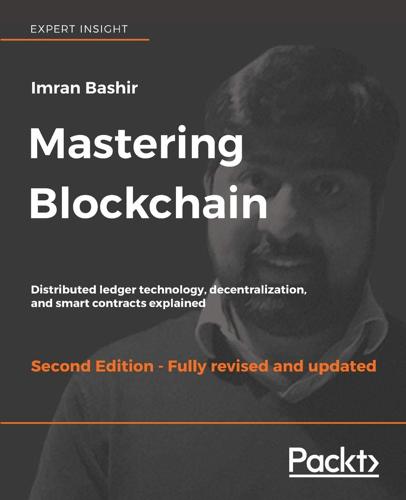
Mastering Blockchain, Second Edition
by
Imran Bashir
Published 28 Mar 2018
Think of it as a calculator that only supports standard preprogrammed arithmetic operations. As such, Bitcoin script language cannot be called Turing complete. In simple words, Turing complete language means that it can perform any computation. It is named after Alan Turing who developed the idea of Turing machine that can run any algorithm however complex. Turing complete languages need loops and branching capability to perform complex computations. Therefore, Bitcoin's scripting language is not Turing complete, whereas Ethereum's Solidity language is. To facilitate arbitrary program development on a blockchain, Turing complete programming language is needed, and it is now a very desirable feature of blockchains.
…
Many organizations around the world have introduced platforms that promise to make distributed application development easy, accessible, and secure. Some of these platforms are described next. Ethereum Ethereum tops the list as being the first blockchain to introduce a Turing-complete language and the concept of a virtual machine. This is in stark contrast to the limited scripting language in Bitcoin and many other cryptocurrencies. With the availability of its Turing-complete language called Solidity, endless possibilities have opened for the development of decentralized applications. This blockchain was first proposed in 2013 by Vitalik Buterin, and it provides a public blockchain to develop smart contracts and decentralized applications.
…
Nevertheless, the security of such languages is a crucial question and an essential and ongoing research area. We will discuss this in greater detail in Chapter 5, Introducing Bitcoin, Chapter 9, Smart Contracts, and Chapter 13, Development Tools and Frameworks, later in this book. Virtual machine: This is an extension of the transaction script introduced earlier. A virtual machine allows Turing complete code to be run on a blockchain (as smart contracts); whereas a transaction script is limited in its operation. However, virtual machines are not available on all blockchains. Various blockchains use virtual machines to run programs such as Ethereum Virtual Machine (EVM) and Chain Virtual Machine (CVM).
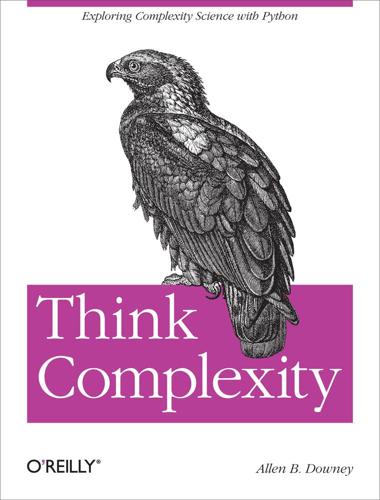
Think Complexity
by
Allen B. Downey
Published 23 Feb 2012
By avoiding uninteresting CAs, Conway was also avoiding Wolfram’s Class 1 and Class 2 behavior, and probably Class 3 as well. If we believe Wolfram’s Principle of Computational Equivalence, we expect GoL to be in Class 4, and it is. The Game of Life was proved Turing complete in 1982 (and again, independently, in 1983). Since then, several people have constructed GoL patterns that implement a Turing machine or another machine known to be Turing complete. Example 7-3. Many named patterns are available in portable file formats. Modify Life.py to parse one of these formats and initialize the grid. Realism Stable patterns in GoL are hard not to notice, especially the ones that move.
…
So far I have focused on scientific challenges to determinism, but the longest-standing objection is the conflict between determinism and human free will. Complexity science provides a possible resolution of this apparent conflict; we come back to this topic in Free Will. Structures The behavior of Class 4 CAs is even more surprising. Several 1-D CAs, most notably Rule 110, are Turing complete, which means that they can compute any computable function. This property, also called universality, was proved by Matthew Cook in 1998. See http://en.wikipedia.org/wiki/Rule_110. Figure 6-5 shows what Rule 110 looks like with an initial condition of a single cell and 100 time steps. At this time scale, it is not apparent that anything special is going on.
…
Functions in this set are called Turing computable. To say that a Turing machine can compute any Turing-computable function is a tautology: it is true by definition. But Turing computability is more interesting than that. It turns out that just about every reasonable model of computation anyone has come up with is Turing complete; that is, it can compute exactly the same set of functions as the Turing machine. Some of these models, like lambda calculus, are very different from a Turing machine, so their equivalence is surprising. This observation led to the Church-Turing thesis, which is essentially a definition of what it means to be computable.
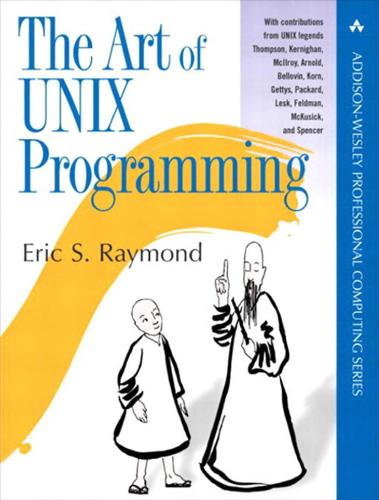
The Art of UNIX Programming
by
Eric S. Raymond
Published 22 Sep 2003
They reach this level when they are explicitly Turing-complete—that is, they can do both conditionals and loops (or recursion)[80] with features that are designed to be used as control structures. Some languages, by contrast, are only accidentally Turing-complete — they have features that can be used to implement control structures as a sort of side effect of what they are actually designed to do. The bc(1) and dc(1) interpreters we looked at in Chapter 7 are good examples of specialized imperative minilanguages that are explicitly Turing-complete. We are over the border into general-purpose interpreters when we reach languages like Emacs Lisp and JavaScript that are designed to be full programming languages run in specialized contexts.
…
The PostScript version of a troff document is derived from the troff source; the command to make the former from the latter is a troff invocation. There are many other kinds of derivation; makefiles can express almost all of them. [80] Any Turing-complete language could theoretically be used for general-purpose programming, and is theoretically exactly as powerful as any other Turing-complete language. In practice, some Turing-complete languages would be far too painful to use for anything outside a specified and narrow problem domain. Applying Minilanguages Designing with minilanguages involves two distinct challenges. One is having existing minilanguages handy in your toolkit, and recognizing when they can be applied as-is.
…
Typing info m4 at your shell prompt will probably display on-line documentation for this language. Example 8.2. A sample m4 macro. define(`OS', `operating system') The m4 macro language supports conditionals and recursion. The combination can be used to implement loops, and this was intended; m4 is deliberately Turing-complete. But actually trying to use m4 as a general-purpose language would be deeply perverse. The m4 macro processor is usually employed as a preprocessor for minilanguages that lack a built-in notion of named procedures or a built-in file-inclusion feature. It's an easy way to extend the syntax of the base language so the combination with m4 supports both these features.
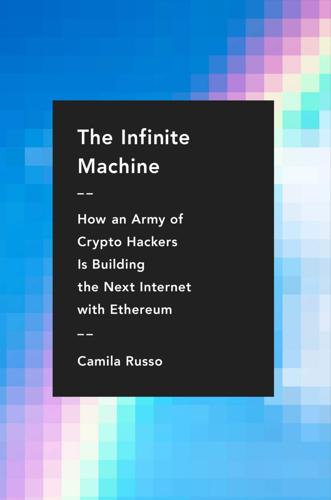
The Infinite Machine: How an Army of Crypto-Hackers Is Building the Next Internet With Ethereum
by
Camila Russo
Published 13 Jul 2020
“The Ethereum Virtual Machine,” Texture said, scrolling through the paper. “Yeah, which is Turing-complete, so it can process whatever piece of code you throw at it,” Adam said. “Turing completeness” is a concept named after mathematician Alan Turing. Turing-complete machines are able to run any computer code. Bitcoin has a scripting language that supports some computation, but Ethereum’s Turing-complete language is designed to support anything a programmer could dream of, and still run in a decentralized way. “The problem with Turing-complete machines is that infinite loops can break them. Like, for example, you ask the computer to add x + x, as long as the result is less than 5, and you also tell it that x equals 1.
…
This makes running applications with self-executing code easier, as there’s no need for someone to pull the trigger. If the purpose of blockchain technology was to remove the middleman, this concept was ingrained at the core of Ethereum. All these parts come together to form a foundational layer: a blockchain with a built-in Turing-complete programming language, allowing anyone to write smart contracts and decentralized applications. Some of the applications that could be created on top of Ethereum, Vitalik wrote, are digital currencies, hedging contracts, a domain-name system, a reputation system, a shareholder-run corporation where decisions on where to move funds can be made by a quorum of investors, “and potentially even the groundwork for a social network.”
…
“Other cryptocurrencies aim to add complexity and increase the number of ‘features,’” he wrote. Ethereum, on the other hand, takes features away. The protocol does not “support” multisignature transactions, multiple inputs and outputs, hash codes, lock times or many other features that even Bitcoin provides. Instead, all complexity comes from an all-powerful, Turing-complete assembly language, which can be used to build up literally any feature that is mathematically describable. By the end of the white paper, Vitalik’s excitement was palpable. “As a result, we have a cryptocurrency protocol whose codebase is very small, and yet which can do anything that any cryptocurrency will ever be able to do,” the paper concluded.
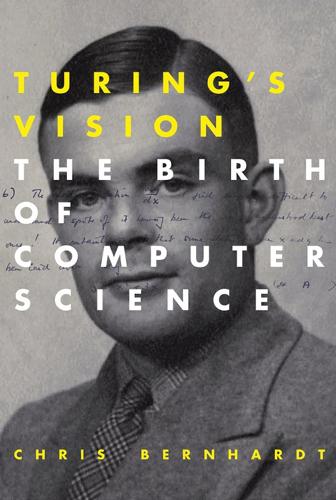
Turing's Vision: The Birth of Computer Science
by
Chris Bernhardt
Published 12 May 2016
In 1961, Minsky showed how any Turing machine can be emulated by a tag system. This means that given any algorithm, there is a tag system that computes it. This fact is sometimes expressed in the literature by saying that tag systems are Turing complete. It has even been shown that you only ever need to consider systems that drop the first two letters — 2-tag systems — to get Turing completeness.10 Given an algorithm, we can in theory design a Turing machine that implements it, and then convert to a tag system. However, the resulting tag system is usually extremely complicated. It would be nice to construct the tag system without first constructing a Turing machine.
…
Consequently, anything a Turing machine, or computer, can do a tag system can do — at least in theory.4 When we looked at one-dimensional cellular automata, we made the observation that some of the rules could be considered as algorithms for computations. Surprisingly, they can also simulate universal Turing machines. Stephen Wolfram conjectured that Rule 110 was Turing complete. This is one of the rules that shows a mixture of chaos and stability depending on the starting tape. For some starting tapes the rule produces very simple output. For other starting tapes the output looks chaotic. Wolfram’s conjecture was that Rule 110 should be able to do any computation whatsoever.
…
(It would be Post who followed up and proved the major results concerning oracles in the 1940s.) But these machines have also proved to be an important part of theoretical computer science. As Robert Soare has commented, you can think of your laptop being a Turing machine and the oracle as being the web. After Turing completed his Ph.D., von Neumann offered him a position as his assistant, but Turing decided not to accept and instead returned to England. During the time that Turing was working on his Ph.D. another breakthrough paper was written. This was on logic and switching circuits and was written by Claude Shannon.
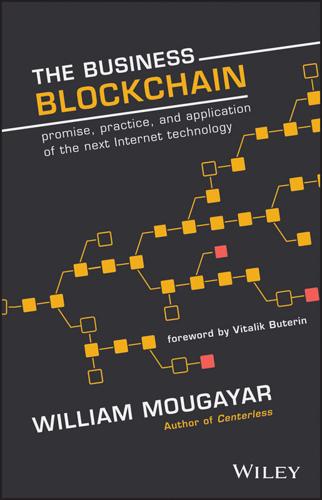
The Business Blockchain: Promise, Practice, and Application of the Next Internet Technology
by
William Mougayar
Published 25 Apr 2016
In 2013, attention started to shift to the “blockchain 2.0” applications: uses of the same technology that underlies Bitcoin's decentralization and security to other applications, ranging from domain name registration to financial contracts to crowdfunding and even games. The core insight behind my own platform, Ethereum, was that a Turing-complete programming language, embedded into the protocol at the base layer, could be used as the ultimate abstraction, allowing developers to build applications with any kind of business logic or purpose while benefiting from the blockchain's core properties. Around the same time, systems such as the decentralized storage platform InterPlanetary File System (IPFS) began to emerge, and cryptographers came out with powerful new tools that could be used in combination with blockchain technology to add privacy, particularly zk-SNARKs, or zero-knowledge Succinct Non-Interactive ARgument Knowledge.
…
Around the same time, systems such as the decentralized storage platform InterPlanetary File System (IPFS) began to emerge, and cryptographers came out with powerful new tools that could be used in combination with blockchain technology to add privacy, particularly zk-SNARKs, or zero-knowledge Succinct Non-Interactive ARgument Knowledge. The combination of Turing-complete blockchain computing, non-blockchain decentralized networks using similar cryptographic technologies, and the integration of blockchains with advanced cryptography was what I chose to call “crypto 2.0”—a title that may be ambitious, but which I feel best captures the spirit of the movement in its widest form.
…
The next generation of smart contracts will include user-friendly entry points, like a Web browser. That will allow any business user to configure smart contracts via a graphical user interface, or perhaps a text-based language input. 8. Smart contracts are safe. Even in the Ethereum implementation, smart contracts run as quasi-Turing complete programs. This means there is finality in their execution, and they do not risk looping infinitely. 9. Smart contract have a wide range of applications. Like HTML, the applications are limited by whoever writes them. Smart contracts are ideal for interacting with real-world assets, smart property, Internet of Things (IoT), and financial services instruments.
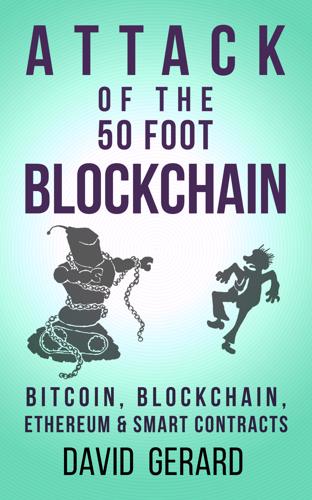
Attack of the 50 Foot Blockchain: Bitcoin, Blockchain, Ethereum & Smart Contracts
by
David Gerard
Published 23 Jul 2017
Humans are bad at tasks requiring perfection. But when programming errors have drastic consequences, the usual approach is to make it harder to shoot yourself in the foot: functional programming languages, formal methods, mathematical verification of the code, don’t use a full computer language (avoid Turing completeness), and so on. Szabo wrote up some requirements and a simple example language in 2002.344 This is particularly important when you have multiple smart contracts interacting with each other – massively concurrent programming, with unknown possibly-hostile programs calling into functions of yours.
…
Development is substantially sponsored by the US government, both for their own use and to help dissidents in oppressive countries. (Even as the NSA doesn’t like it at all.) Also favoured by Internet trolls and darknet users. Tulip: a pretty flower, and the subject of the 1637 bubble known as “tulip mania,” one of the first well-documented bubbles. Turing complete: when a computer or computer language is sophisticated enough that it can theoretically solve any problem that any other computer can … given enough memory and time. You often don’t want this, because it makes it harder to prove mathematical correctness when you really need to be certain, e.g. in a smart contract.
…
Petersburg Bowl 77 Status 95, 98 Stellar 48 Stephenson, Neal 19 streaming 127 Szabo, Nick 19, 32, 59, 101, 102, 105, 107 TAO, The 135 TechUK 115 Telstra 73 Temkin, Max 75 Thiel, Peter 18 Thornburg, Jonathan 23 Tiny Human 129 Today (Radio 4) 67 Todd, Peter 59, 68 Top500 65 Tor 49, 59 Tual, Stephen 109 Tucker, Jeffrey 40 Tulip Mania 35 Tulip Trust 64 Turing completeness 107 Ujo Music 129 UK Government Office for Science 123 Ukash 73 Ulbricht, Lyn 53 Ulbricht, Ross 26, 48, 64 unbanked 29 Underhanded C Contest 106 Underhanded Solidity Coding Contest 106 Venezuela 31 Ver, Roger 17, 37, 44, 47, 48, 50 virtual reality 135 Visa 28, 36 wallet 12 Walpole, Sir Mark 123 WannaCry 73 Washington Post 32 Wells Fargo 87 Western Union 28 Westwood, Adam 64 WhollyHemp 76 WikiLeaks 36, 62 Wikimedia Foundation 76 Wikipedia 76 Wilcke, Jeffrey 94 Willybot 82 Winter Olympics 93 Wired 64 Wise, Josh 93 Wood, Gavin 94 WordPress 75 Wright Family Trust 63 Wright, Craig 61, 139 Yapizon 89 YouTube 137 Zamovskiy, Andrey 120 Zero Hedge 24 Zhoutong 83 Notes [1] Satoshi Nakamoto.

Enshittification: Why Everything Suddenly Got Worse and What to Do About It
by
Cory Doctorow
Published 6 Oct 2025
2 The End of Self-Help No one has ever figured out how to make a computer that only runs the programs that its manufacturer desires. As I noted on page 59, the modern computer is universal in a highly technical sense: the “Turing-complete, universal von Neumann machine” is a mid-century innovation, the product of a heavily funded Allied Army technical project that was, in its own way, even more seismic than the Manhattan Project. Turing-complete refers to Alan Turing, the gay computer scientist who, during World War II, led a group of brilliant mathematicians (including a cadre of exiled Poles) and code breakers (including a motley assortment of crossword puzzle experts and other weirdos) at Bletchley Park, a secluded estate between Cambridge and Oxford, in an effort to break the Nazis’ Enigma cipher.1 Across the ocean, John von Neumann (as in universal von Neumann machine) led a group of exiled Hungarians and colleagues from around the world at the Princeton Institute in devising a new physical architecture for a computing machine.
…
But two other sources of discipline exist that are unique to tech: self-help and tech workers. The Discipline of Self-Help1 Let’s start with self-help. Digital computers are marvelously flexible in a way that non–computer scientists seldom grasp. Technically speaking, every computer you use is a “Turing-complete, universal von Neumann machine.” This is mid-century computer science jargon that I could spend a whole book explaining. (The giveaway is the names of those two wartime computer scientists Alan Turing and John von Neumann.) But the bottom line is this: Every computer we know how to make is capable of running every computer program we know how to write.
…
Worse, if you add a single Android user to an iMessage group chat, all the messages within that group are sent without any protection. Why would Apple do this? It’s not that it’s technically challenging to create an Android app that can send and receive iMessages. Think back to page 133 and the inescapable reality that every computer is a Turing-complete, universal von Neumann machine. That means that every program that can run on an iPhone can run on an Android device and vice versa. The reason to block iMessages on Android, and to expose every Apple customer in the world to completely avoidable, absolutely terrifying security risks, is right there in Tim Cook’s zinger to LiQuan Hunt: “Buy your mom an iPhone.”

Blockchain Revolution: How the Technology Behind Bitcoin Is Changing Money, Business, and the World
by
Don Tapscott
and
Alex Tapscott
Published 9 May 2016
(Prolific founder, that is.) Ask his legion of followers about Ethereum, and they’ll tell you it’s a “blockchain-based, arbitrary-state, Turing-complete scripting platform.”1 It has attracted IBM, Samsung, UBS, Microsoft, and the Chinese auto giant Wanxiang, and an army of the smartest software developers in the world, all of whom think that Ethereum may be the “planetary scale computer” that changes everything.2 When Buterin explained “arbitrary-state, Turing-complete” to us, we got a glimpse of his mind. Listening to music is very different from reading a book or calculating the day’s revenues and expenses, and yet you can do all three on your smart phone, because your smart phone’s operating system is Turing complete.
…
Listening to music is very different from reading a book or calculating the day’s revenues and expenses, and yet you can do all three on your smart phone, because your smart phone’s operating system is Turing complete. That means that it can accommodate any other language that is Turing complete. So innovators can build just about any digital app imaginable on Ethereum—apps that perform very dissimilar tasks, from smart contracts and computational resource marketplaces to complex financial instruments and distributed governance models. Buterin is a polyglot. He speaks English, Russian, French, Cantonese (which he learned in two months on vacation), ancient Latin, ancient Greek, BASIC, C++, Pascal, and Java, to name a few.3 “I specialize in generalism,” he said.
…
See Design principles ShapeShift, 260 Shapiro, Melanie, 287 Shareholders, 11, 78–79, 100, 107, 125–28 Sharing economy, 17–18, 134–35, 187 Sidechains, 60 Silbert, Barry, 86, 284 Silk Road, 9, 276 Simplified payment verification (SPV), 50 Simpson, Arianna, 287 Skogstad, Anselm, 240 Skynet, 273 Slack, 89 Smart contracts, 101–3, 109, 126, 142, 219 aid groups and, 190 DApps, 120, 121 definition of, 101–2 MFIs and, 192 multisig authentication, 103–5 ownership rights and, 46–48 for political reputations, 210–11 Smart devices, 150–54 economic payoffs, 161–64 future developments, 164–67 hacking your future, 168–69 twelve disruptions, 156–61 Smart homes, 161, 275 Smart locks, 117 Smart pills, 151, 158 Smartwallet, 83, 131, 153 Snow Crash (Stephenson), 38, 315n Snowden, Edward, 243 Social contracts, 99 Social energy, 148–50 Social production, 129–32 Social Security, 80, 176 Societal change, 257–58 Society for Worldwide Interbank Financial Telecommunication (SWIFT), 42, 59, 262 Society of European Stage Authors and Composers (SESAC), 229 Song, Dawn, 288 Sony Music Entertainment, 229, 230 Soul of a New Machine, The (Kidder), 150 Spain, Agora Voting, 218–19 Spam, 34, 39, 255, 321n Spotify, 88, 229, 230, 239, 319n Srinivasan, Balaji, 178–79 Stakeholders, 262 Standards networks, 304–6 Stark, Elizabeth, 288 Steiner, Peter, 3 Stellar, 32, 37, 170–71 Stellar Development Foundation, 170–71 Stephenson, Neal, 315 Stiglitz, Joseph, 35–36, 57, 107 Storing value, in financial services, 61–62, 64 Storj, 95, 120 Streaming music, 229, 230 Streaming open and trusted data, 208–9 Streamium, 233 Student debt, 248–49 SUber, 165–67 Subledger, 73–74 Surveillance, 25, 42, 44–45, 212, 243–44, 274–75 Swan, Melanie, 110, 204, 224, 247–49 Sybil attacks, 36, 37, 315n Systemic risk, 59 Szabo, Nick, 4–5, 37, 101–2, 255 Talking Heads, 227, 228 “Taps,” 146–47 Tapscott, Bob, 261, 268 Taylor, Simon, 75 TCP/IP (Transmission Control Protocol/Internet Protocol), 43, 50 Technology democracy and, 212–14 as implementation challenge, 254–58 Termen, Lev Sergeyevich, 253–54, 277 Terms of third-party engagement, 234 Tezos, 95 Theory of the firm, 92–93, 100, 105–6, 121, 319n Theremin, 253–54 Thiel, Peter, 93–94 360-degree deals, 229 Ticoll, David, 25, 109, 134 Tinsley, Michelle, 155 Title registration, 8, 19–20, 51, 188–89, 193–95, 198 Todd, Peter, 133, 268 Tools of abundance, 178–79 Top-down management, 89, 92, 106 Tor, 263 Torvalds, Linus, 88, 282 Totalitarianism, 34, 52, 141, 145 TradeNet, 165 Trading volume, 256 Transactional capacity, 255 Transaction costs, 92–93, 95–101, 107, 142, 193, 269 Transparency, 10, 11, 298 aid groups and, 190–91 design principles and, 30, 39, 41, 44, 45 financial services and, 66–67, 77 government and political institutions, 205, 210, 296 MFIs and, 192 music and, 232–33, 236 Transportation, 137, 156–57, 164–67, 206 Treat, David, 70 Triple-entry accounting, 77, 78–79, 180 Trump, Donald, 210 Trust achieving in the digital age, 10–11 costs of (re-)building, 107–9, 143 networked integrity, 30–33 in political institutions, 201–2 Trust Barometer, 10 Trusted data, 208–9 Trusted systems. See Walled gardens Trust protocol, 4–6, 58, 309–11 Turing completeness, 278 22Hertz, 237–38 Twister, 246 Twoway peg, 60 Uber, 17, 118, 134, 135, 164–65, 270 Ulbricht, Ross William, 9 Unbanked and underbanked, 170–72, 175–78 Unemployment, 173 UNESCO, 249 UNICEF, 189–90 Unicoin, 190 Unique node list, 32 Universal Music, 229, 230 Usage data analytics, 233–34 Utility grids, 145–50 Value as incentive, 35–39, 202 Value innovation, 60 Value templates, 232 Vavilov, Valery, 261, 268 “Vectors of disruption,” 163 Vegetabile, Andrew, 267 Venture capitalists (VCs), 284, 287 Ver, Roger, 263, 284 VeriCoin, 266 VerifyID, 116 Verisart, 133 Vertical search, 97 Virtru Corporation, 40 Virtual private networks (VPNs), 118 Visa, 187–88 Vogogo, 72 Voorhees, Erik, 56, 81–82, 260, 284 Voter ID fraud, 217 Voter intimidation, 216–17 Voter turnout, 200–201 Voting, 198, 202, 214–15, 218–19 electronic (e-voting), 198, 215–17 Waldemeyer, Moritz, 228 Wales, Jimmy, 282 Walled gardens, 13, 70, 265 Warner Music Group, 229 Wassenaar Arrangement, 243–44 Waste management, in IoTs, 157 Watchdog networks, 303–4 Water management, in IoTs, 157 Wealth of Networks, The (Benkler), 277 Wealth tax, 173 WeatherDApp, 124–25 Weathernet, 123–24 WeatherNodes, 123–25, 147, 158 Western Union, 20, 56, 115, 185–86, 187–88 WhatsApp, 184 White, Derek, 68–69 Wikinomics, 128, 137 Wikipedia, 12, 129, 130–32, 282 Wilkins, Carolyn, 9, 294, 295–96 Williamson, Oliver, 93–94, 100, 105–6, 320n Windowing strategy, 235–36 Winklevoss, Tyler, 175, 255–56, 301 Winter, Alex, 21 Wisdom of the crowds, 84–85, 221 WISeKey, 11, 14, 154, 204 Women leaders in blockchain, 287–89 Wong, Pindar, 300, 305 Wood, Gavin, 119 World Bank, 193, 295, 300 World Economic Forum (WEF), 175, 270, 306 World Health Organization, 281 World Trade Organization, 281 World Wide Ledger, 6–8, 75–77, 95–96, 142 World Wide Web Consortium, 271, 299 Wozniak, Steve, 129, 274 Wright, Aaron, 103, 258, 264, 265, 293 YouTube, 230, 234, 235, 236 Zeall, Anson, 217 Zelaya, Manuel, 193 Zero to One (Thiel), 94 Zimbabwe, voter intimidation, 216–17 Zipcar, 134, 137, 187 Zyskind, Guy, 27–28 Looking for more?

Lurking: How a Person Became a User
by
Joanne McNeil
Published 25 Feb 2020
Until then, the internet remains imperfect, a hell that is fun, ruled by idiots and thieves, providing users with slingshots for self-expression but no shield from the bile that rebounds. It is our potential, our conscription, and our reality: platforms that trap us, platforms that cannot accommodate us, platforms that don’t deserve us. NOTES INTRODUCTION Olia Lialina’s 2012 essay “Turing Complete User” is available on her website: contemporary-home-computing.org/turing-complete-user/. The email from a Mechanical Turk worker to Jeff Bezos was part of a letter-writing campaign organized through the MTurk collective Dynamo. Will Oremus has written about Amazon as a surveillance company, with products like Ring and Echo, in the Medium publication OneZero (“Amazon Is Watching,” June 27, 2019).
…
“User” is a particular status, activity, and state of being, but the word is hated by some. Don Norman, who coined “UX”—user experience—said in 2008, “One of the horrible words we use is ‘users.’ I am on a crusade to get rid of the word ‘users.’ I would prefer to call them ‘people.’” But the word “people,” as the artist Olia Lialina responded in her essay, “Turing Complete User,” hides the “existence of two classes of people—developers and users.” It is not a mellifluous word or elegant, but “user” is, uh, useful. Developers scripted these mazes, these interfaces, which users use to communicate and keep in touch. There are humans on the outside and humans on the inside; the platforms created by and used by humans outline and define identities, boxing users in, while tendering new methods of expression.

Turing's Cathedral
by
George Dyson
Published 6 Mar 2012
“Only because of our conversation on the bench in Central Park I was able to understand…[that] given is an actually infinite system of points (the actual infinity is worth stressing because nothing will make sense on a finite no matter how large model),” noted Ulam, who then sketched out how he and von Neumann had hypothesized the evolution of Turing-complete (or “universal”) cellular automata within a digital universe of communicating memory cells. The definitions had to be made mathematically precise: A “universal” automaton is a finite system which given an arbitrary logical proposition in form of (a linear set L) tape attached to it, at say specified points, will produce the true or false answer.
…
“Double line trick, etc.” is evocative of the double-helix replication of DNA, and “Degeneration (?)” probably refers to how any enduring system of self-reproduction must depend on error-correcting codes in translating from one generation to the next. “Ulam!” probably refers to Ulam’s interest in the powers of Turing-complete cellular automata, now evidenced by many of the computational processes surrounding us today. The triplicate appearance of “Turing!” reflects how central Turing’s proof of universality was to any theory of self-reproduction, whether applied to mathematics, biology, or machines. The Institute for Advanced Study computer was duplicated, with variation, by a first generation of immediate siblings that included SEAC in Washington, D.C., ILLIAC at the University of Illinois, ORDVAC at Aberdeen, JOHNNIAC at the RAND Corporation, MANIAC at Los Alamos National Laboratory, AVIDAC at Argonne, ORACLE at Oak Ridge, BESK in Stockholm, DASK in Copenhagen, SILLIAC in Sydney, BESM in Moscow, PERM in Munich, WEIZAC in Rehovot, and the IBM 701.
…
“This synthesis can be executed by a digital computer, in particular, by the computer to be designed if sufficiently large,” they reported in April 1956, concluding that “it appears that we have thereby exhibited a machine which can reproduce (i.e. design) itself. This result seems to be related to the self-reproducing machines of von Neumann.”19 They were right. Codes populating the growing digital universe soon became Turing-complete, much as envisioned by Ulam and von Neumann in 1952. Turing’s ACE, a powerful Universal Machine, was to have had a memory of 25 kilobytes, or 2 × 105 bits. The present scale of the digital universe has been estimated at 1022 bits. The number of Turing machines populating this universe is unknown, and increasingly these machines are virtual machines that do not necessarily map to any particular physical hardware at any particular time.
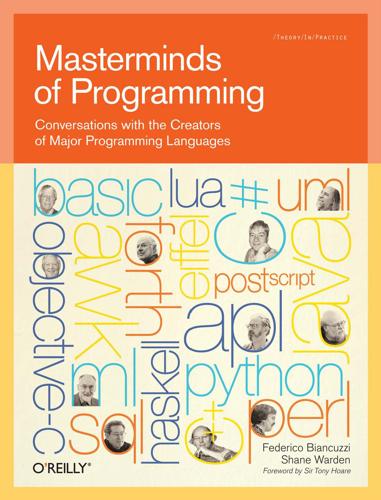
Masterminds of Programming: Conversations With the Creators of Major Programming Languages
by
Federico Biancuzzi
and
Shane Warden
Published 21 Mar 2009
PIC started out only able to draw, but it rapidly became clear that it needed arithmetic expressions to handle computations on coordinates and the like, and it needed variables to store results, and it needed loops to create repetitive structures. All of these were added, but each one was kind of awkward and shaky. In the end, PIC was quite powerful, a Turing-complete language, but one wouldn’t want to write a lot of code in it. How do you define success in terms of your work? Brian: One of the most rewarding things is to have someone say that they used your language or tool and found that it helped them get their job done better. That’s really satisfying.
…
It’s a difficult balance, and I think he did a very good job. To what degree can you pursue backward compatibility versus trying to introduce something new and revolutionary? Brian: That’s a dilemma in absolutely every field, and I don’t see any way out of it. You mentioned that a lot of little languages started adding features and becoming Turing-complete and losing their conceptual purity. Are there design principles to apply if you’re taking a little language and making it more general purpose without losing its way? Brian: I guess. I remember saying that on a variety of occasions, and I often wondered how much of it was a parochial view. That is, all of the languages I had touched had this property and maybe nothing else did.
…
Extensibility The language should have a well-defined, general-purpose mechanism whereby new functionality can be added, ideally with little or no impact on the syntax of the language. For example, a database query language might provide a facility for adding user-defined functions written in a separate Turing-complete programming language. Abstraction The language should not expose or depend on aspects of a specific implementation. For example, eliminating duplicates from a set of values should be specified in terms of an abstract concept such as a “primary key” rather than a physical strategy such as a “unique index.”

Cryptoassets: The Innovative Investor's Guide to Bitcoin and Beyond: The Innovative Investor's Guide to Bitcoin and Beyond
by
Chris Burniske
and
Jack Tatar
Published 19 Oct 2017
Dmitry Buterin is also very much involved in the cryptoasset world as cofounder of Blockgeeks and other influential startups. 3. http://fortune.com/ethereum-blockchain-vitalik-buterin/. 4. http://www.ioi2012.org/competition/results-2/. 5. https://backchannel.com/the-uncanny-mind-that-built-ethereum-9b448dc9d14f#.4yr8yhfp8. 6. https://blog.ethereum.org/2014/01/23/ethereum-now-going-public/. 7. http://counterparty.io/platform/. 8. https://steemit.com/ethereum/@najoh/beyond-bitcoin-and-crypto-currency-ethereum. 9. https://blog.ethereum.org/2014/01/23/ethereum-now-going-public/. 10. https://github.com/ethereum/wiki/wiki/white-paper. 11. Turing complete refers to a system that is effectively capable of the full functionality of a general purpose computer. Bitcoin was intentionally constructed not to be Turing complete to constrain complexity and prioritize security. 12. https://ethereum.org/ether. 13. Nathaniel Popper, Digital Gold: Bitcoin and the Inside Story of the Misfits and Millionaires Trying to Reinvent Monday, Harper, 2015. 14. http://www.coindesk.com/peter-thiel-fellowship-ethereum-vitalik-buterin/. 15. http://www.wtn.net/summit-2014/2014-world-technology-awards-winners. 16. http://ether.fund/market. 17. https://www.ethereum.org/foundation. 18. https://blog.ethereum.org/2015/03/14/ethereum-the-first-year/. 19. http://ethdocs.org/en/latest/introduction/history-of-ethereum.html. 20. http://ether.fund/market. 21. http://ethdocs.org/en/latest/introduction/history-of-ethereum.html. 22.
…
By having no affiliation with “coin” in its name, Ethereum was moving beyond the idea of currency into the realm of cryptocommodities. While Bitcoin is mostly used to send monetary value between people, Ethereum could be used to send information between programs. It would do so by building a decentralized world computer with a Turing complete programming language.11 Developers could write programs, or applications, that would run on top of this decentralized world computer. Just as Apple builds the hardware and operating system that allows developers to build applications on top, Ethereum was promising to do the same in a distributed and global system.
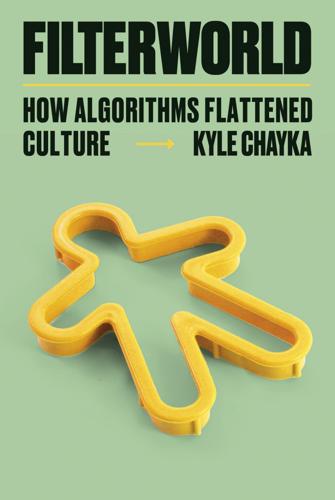
Filterworld: How Algorithms Flattened Culture
by
Kyle Chayka
Published 15 Jan 2024
The tape moves through a reader that scans one square at a time and performs the operation dictated by the symbol in the square, which can also be erased or overwritten. Any algorithm, in the historical sense of a mathematical process, can be calculated by such a Turing Machine. And any computational system that can compute anything that a Turing Machine can is said to be “Turing-complete.” All programming languages, for example, are Turing-complete because they can model any kind of equation. (Even the spreadsheet software Excel became Turing-complete in 2021.) What Turing correctly concluded was that any computing machine would be able to do the work of any other—even Charles Babbage’s nineteenth-century Analytical Engine could theoretically perform the complex tasks that our laptops do now, if given infinite scale and time.
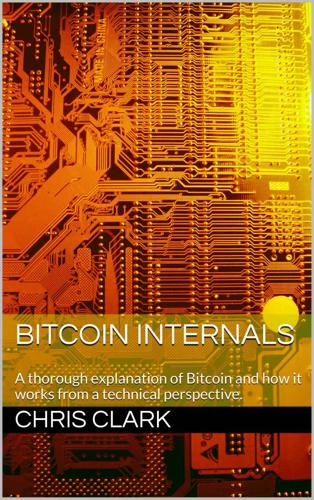
Bitcoin Internals: A Technical Guide to Bitcoin
by
Chris Clark
Published 16 Jun 2013
This ensures that these parameters of the transaction can not change without a new signature. The script in Bitcoin looks quite a bit different though, because Bitcoin uses its own custom scripting language. 7.3 Scripting The scripting language used in Bitcoin is a stack-based language similar to Forth. It is intentionally not Turing-complete so that it can be executed without concern for whether the script will hang. It works like a reverse polish notation calculator. The script is read from left to right. When a value is encountered in the script, it is pushed onto a stack. When an operator is encountered in the script, some values are popped off the stack, the operator is applied to these values, and the result is pushed onto the stack.

The Innovators: How a Group of Inventors, Hackers, Geniuses and Geeks Created the Digital Revolution
by
Walter Isaacson
Published 6 Oct 2014
BLETCHLEY PARK Although few outsiders knew it at the time—and would not know for more than three decades—another electronic computer using vacuum tubes had been secretly built at the end of 1943 on the grounds of a redbrick Victorian manor in the town of Bletchley, fifty-four miles northwest of London, where the British had sequestered a team of geniuses and engineers to break the German wartime codes. The computer, known as Colossus, was the first all-electronic, partially programmable computer. Because it was geared for a special task, it was not a general-purpose or “Turing-complete” computer, but it did have Alan Turing’s personal fingerprints on it. Turing had begun to focus on codes and cryptology in the fall of 1936, when he arrived at Princeton just after writing “On Computable Numbers.” He explained his interest in a letter to his mother that October: I have just discovered a possible application of the kind of thing I am working on at present.
…
It was also a special-purpose computer and not programmable. Herman Zuse’s Z3, completed in May 1941, was the first automatically controlled, programmable, electrical, binary machine. It was designed to do engineering problems rather than be a general-purpose machine. However, it was later shown that, in theory, it could have been used as a Turing-complete machine. Its major difference from modern computers was that it was electromechanical, dependent on clacking and slow relay switches, rather than electronic. Another shortcoming is that it never really went into full-scale service. It was destroyed by the Allied bombing of Berlin in 1943. The computer designed by John Vincent Atanasoff, which was complete but not fully workable by the time Atanasoff abandoned it to serve in the Navy in September 1942, was the world’s first electronic digital computer, but it was only partly electronic.
…
Also, Atanasoff never got it fully operational, and it disappeared into a basement at Iowa State. Bletchley Park’s Colossus I, completed in December 1943 by Max Newman and Tommy Flowers (with input from Alan Turing), was the first digital computer that was fully electronic, programmable, and operational. It was not, however, a general-purpose or Turing-complete machine; it was geared to the specific purpose of breaking Germany’s wartime codes. Howard Aiken’s Harvard Mark I, built with IBM and put into operation in May 1944, was programmable, as we will see in the following chapter, but it was electromechanical rather than electronic. ENIAC, completed by Presper Eckert and John Mauchly in November 1945, was the first machine to incorporate the full set of traits of a modern computer.
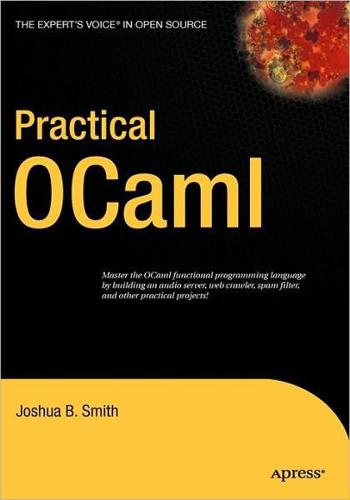
Practical OCaml
by
Joshua B. Smith
Published 30 Sep 2006
Less Code There are several reasons why this is true, and one of the biggest is that functional languages are often more terse than their structured counterparts. This terseness does not hamper their expressiveness, and because functional languages are just as Turing-complete as their structured brethren. Expressiveness is more than simple Turing completeness; the functional programming style encourages short functions that perform simple actions. Less code is also a direct result of more general modularity. The ability to decompose problems into smaller parts is dependent on the ability to utilize those parts.
…
Random BMP 620Xch27final.qxd 9/22/06 1:22 AM Page 389 CHAPTER 27 ■ PROCESSING BINARY FILES Figure 27-3. xor BMP Figure 27-4. and BMP 389 620Xch27final.qxd 390 9/22/06 1:22 AM Page 390 CHAPTER 27 ■ PROCESSING BINARY FILES Conway’s Game of Life In 1970, a British mathematician named John Conway created the field of cellular automata when he published the first article on the subject. Conway’s “game” isn’t so much a game played by people as it is a mathematical experiment. The game is an example of emergent behavior because there are only four simple rules that generate an amazing amount of complexity. Conway’s game is also Turing Complete, which means that (given the right initial conditions) the game is as powerful as any “real” computer. The game itself is represented (in its original version) by a matrix of cells. These cells can be either alive or dead, as determined by the cells’ neighbors and the rules of the game. This representation of cells is why Conway’s game provides an excellent graphical target to shoot for.
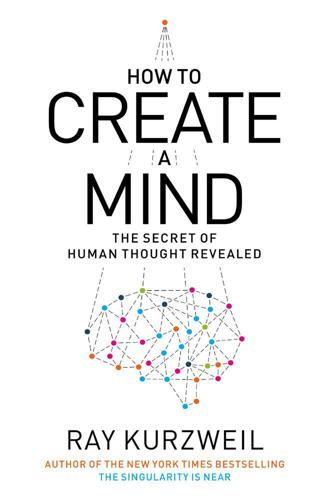
How to Create a Mind: The Secret of Human Thought Revealed
by
Ray Kurzweil
Published 13 Nov 2012
Turing and Alonzo Church (1903–1995), his former professor, went on to develop the Church-Turing thesis, which states that if a problem that can be presented to a Turing machine is not solvable by it, it is also not solvable by any machine, following natural law. Even though the Turing machine has only a handful of commands and processes only one bit at a time, it can compute anything that any computer can compute. Another way to say this is that any machine that is “Turing complete” (that is, that has equivalent capabilities to a Turing machine) can compute any algorithm (any procedure that we can define). A block diagram of a Turing machine with a head that reads and writes the tape and an internal program consisting of state transitions. “Strong” interpretations of the Church-Turing thesis propose an essential equivalence between what a human can think or know and what is computable by a machine.
…
Because the Turing machine (and therefore any computer) is capable of basing its future course of action on results it has already computed, it is capable of making decisions and modeling arbitrarily complex hierarchies of information. In 1939 Turing designed an electronic calculator called Bombe that helped decode messages that had been encrypted by the Nazi Enigma coding machine. By 1943, an engineering team influenced by Turing completed what is arguably the first computer, the Colossus, that enabled the Allies to continue decoding messages from more sophisticated versions of Enigma. The Bombe and Colossus were designed for a single task and could not be reprogrammed for a different one. But they performed this task brilliantly and are credited with having enabled the Allies to overcome the three-to-one advantage that the German Luftwaffe enjoyed over the British Royal Air Force and win the crucial Battle of Britain, as well as to continue anticipating Nazi tactics throughout the war.

The Truth Machine: The Blockchain and the Future of Everything
by
Paul Vigna
and
Michael J. Casey
Published 27 Feb 2018
Here are just a few: digital “self-sovereign” identity; decentralized medical record sharing; automated, market-driven solar microgrids; decentralized commodity exchanges; crowdfunded, ownerless investment funds; blockchain-certified marriage certificates; provably secure online voting systems; decentralized supply-chain and logistics platforms; security for the Internet of Things. The list goes on and on. Ethereum’s internal programming language is described as being “Turing complete”—which essentially means it has great versatility, allowing people to write an unlimited variety of programs. The key breakthrough was that this structure, beyond its easy-to-use programming language, would enable smart contracts. As they were first raised in the pre-Bitcoin era by crypto-systems theorist Nick Szabo, smart contracts are a way to express, in a piece of computing code, instructions for executing transactions according to previously agreed contractual conditions.
…
See also ledger-keeping Trump, Donald trust, distributed trusted computing Trusted Computing Group Trusted IoT Alliance trusted third parties and Bitcoin and blockchain-inspired startups and blockchain property registries and cloud computing and energy sector and governance and identity and permissioned systems truth discovery truth machine Tual, Stephan Turing, Alan “Turing complete” Uber “God’s View” knowledge Ubitquity UBS Ujo Ulbricht, Ross UNESCO Union Square Ventures United Kingdom Brexit Financial Conduct Authority Government Office for Science blockchain report and universal basic income United Nations UN High Commission for Refugees (UNHCR) UNHCR identity program World Food Program (WFP) universal basic income (UBI) user attention Veem venture capital (VC) Ver, Roger Veripart Verisign Vertcoin Vigna, Paul.
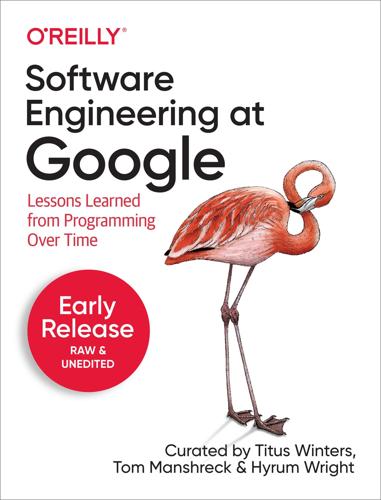
Software Engineering at Google: Lessons Learned From Programming Over Time
by
Titus Winters
,
Tom Manshreck
and
Hyrum Wright
Published 17 Mar 2020
This is exactly the approach taken by Blaze and the other artifact-based build systems descended from it (which include Bazel, Pants, and Buck). Like with task-based build systems, we still have buildfiles, but the contents of those buildfiles are very different. Rather than being an imperative set of commands in a Turing-complete scripting language describing how to produce an output, buildfiles in Blaze are a declarative manifest describing a set of artifacts to build, their dependencies, and a limited set of options that affect how they’re built. When engineers run blaze on the command line, they specify a set of targets to build (the “what”), and Blaze is responsible for configuring, running, and scheduling the compilation steps (the “how”).

Silence on the Wire: A Field Guide to Passive Reconnaissance and Indirect Attacks
by
Michal Zalewski
Published 4 Apr 2005
Nevertheless, we can provide plenty of it, making such a hardware Turing machine quite usable for most of our everyday problems. Enter the universal computer. Real computers, of course, go far beyond the sequential access single-bit memory, thus significantly reducing the set of instructions required to achieve Turing completeness. A UTM with an alphabet of 18 characters requires only two internal states in order to work. Real computers, on the other hand, usually operate on an “alphabet” of at least 4,294,967,296 characters (32 bits), and often far more, which allows for nonsequential memory access and for the use of a large number of registers with an astronomical number of possible internal states.
…
Universal Turing Machines can do just about everything (in many cases, by virtue of their simplicity), but they are painfully slow and difficult to program, to a degree that even implementing machine-assisted translation from more human-readable languages to machine code is difficult, at least without driving the programmer clinically insane. Architectures or languages that come too close to implementing bare-bones Turing completeness are often referred to as Turing tarpits. This means that, while it is theoretically possible to carry out just about any task with their help, in practice, it is barely feasible, too time-consuming, and too burdensome to actually try. Even simpler tasks such as integer multiplication or moving the contents of memory can take forever to set up, and twice as long to execute.
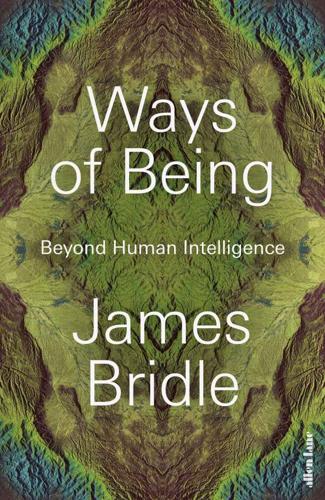
Ways of Being: Beyond Human Intelligence
by
James Bridle
Published 6 Apr 2022
The first step in divesting ourselves of the illusion of mastery comes with language. Earlier, I mentioned in passing the existence of non-standard, and particularly non-English, programming languages. A favourite example of these is قلب, which is pronounced ‘alb’ or ‘qalb’ and, in English, means ‘heart’. قلب is a Turing-complete language, meaning it is capable of implementing all existing computer programmes and includes a complete Arabic interpreter and programming environment – the tools for running and writing code. Like Arabic, it is written left to right, and all keywords – usually English terms such as ‘loop’ and ‘function’ – are replaced with meaningful Arabic equivalents.
…
Or there’s Emojicode, a complete programming language written in, yes, emojis.28 At the extreme end of such endeavours is Brainfuck, an esoteric language created in 1993 by another physicist, Urban Müller, which consists of just eight commands, themselves consisting of just a single character: < > + -., [ and ]. Like قلب, Brainfuck is Turing-complete, meaning that from these eight characters the whole of existing computation can be extruded – although doing so is an endeavour worthy of the language’s name.29 Here is ‘Hello World!’ in Brainfuck: ++++++++++[>+++++++>++++++++++>+++<<<- ]>++.>+.+++++++..+++.>++.<<+++++++++++++++.>.+++.------.--------.>+.

Accelerando
by
Stross, Charles
Published 22 Jan 2005
He's not sure Pamela ever let him see her fully naked: She thought skin was more sexy when it was covered. Annette squeezes him again, and he stiffens. "More!" By the time they finish, he's aching, and she shows him how to use the bidet. Everything is crystal clear, and her touch is electrifying. While she showers, he sits on the toilet seat lid and rants about Turing-completeness as an attribute of company law, about cellular automata and the blind knapsack problem, about his work on solving the Communist Central Planning problem using a network of interlocking unmanned companies. About the impending market adjustment in integrity, the sinister resurrection of the recording music industry, and the still-pressing need to dismantle Mars.
…
If Amber sells herself into slavery to this company, she will become a slave and the company will be legally liable for her actions and upkeep. The rest of the legal instrument – about ninety percent of it, in fact – is a set of self-modifying corporate mechanisms coded in a variety of jurisdictions that permit Turing-complete company constitutions, and which act as an ownership shell for the slavery contract. At the far end of the corporate shell game is a trust fund of which Amber is the prime beneficiary and shareholder. When she reaches the age of majority, she'll acquire total control over all the companies in the network and can dissolve her slave contract; until then, the trust fund (which she essentially owns) oversees the company that owns her (and keeps it safe from hostile takeover bids).
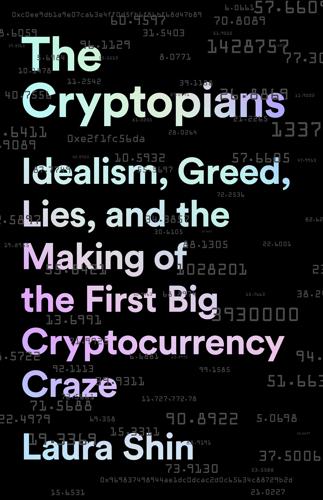
The Cryptopians: Idealism, Greed, Lies, and the Making of the First Big Cryptocurrency Craze
by
Laura Shin
Published 22 Feb 2022
No need for phone calls or any human interaction—just anyone who wanted to invest in and use CabCoin could transact directly with the contract, or they could program a contract of their own to do it, eliminating the need for people entirely. Everything on Ethereum—a trading exchange, a betting site, a decentralized domain name system, a corporation of shareholders, insurance, a decentralized marketplace—would be a contract. And the language used would be “Turing complete,” meaning it would be able to express any concept a developer might want. Vitalik ended this new version of the white paper as follows: The Ethereum protocol’s design philosophy is in many ways the opposite from that taken by many other cryptocurrencies today. Other cryptocurrencies aim to add complexity and increase the number of “features”; Ethereum, on the other hand, takes features away.
…
Other cryptocurrencies aim to add complexity and increase the number of “features”; Ethereum, on the other hand, takes features away. The protocol does not “support” multisignature transactions, multiple inputs and outputs, hash codes, lock times or many other features that even Bitcoin provides. Instead, all complexity comes from an all-powerful, Turing-complete assembly language, which can be used to build up literally any feature that is mathematically describable. The language itself follows an Orwellian Newspeak principle; any instruction which can be replaced by a sequence of less than four other instructions has been removed. As a result, we have a cryptocurrency protocol whose codebase is very small, and yet which can do anything that any cryptocurrency will ever be able to do.

Beautiful Architecture: Leading Thinkers Reveal the Hidden Beauty in Software Design
by
Diomidis Spinellis
and
Georgios Gousios
Published 30 Dec 2008
With the <fb:-if-can-see> tag and others like it, an application can specify a target user in the attributes such that the child elements are rendered only if the viewer can see that target user’s specific content. Thus, the privacy values themselves are not exposed to the application, yet it allows an application to enforce privacy. In this sense, FBML is a trusted declarative execution environment, in contrast to an imperative execution environment such as C or PHP. In a strict sense, FBML is not “Turing-complete” like these languages (for instance, no looping constructs are available). Much like HTML itself, no state can be saved during the execution except that implied by the tree traversal; for instance, <fb:tab-item> makes sense only within <fb:tabs>. However, FBML enables a great deal of the functionality that most developers want to provide to their users, through making data available to the user within the trusted system.
…
Iverson (of APL fame) was devoted to the importance of notation for expressing our thoughts. The SWH is controversial—after all, everybody has had the experience of not being able to find the words for something, so we are able to think of more than we can say—but in computer code the link between languages and programs is clear. We know that computer languages are Turing complete, but we also know that for some things some languages fit better than others. But apart from influencing program architecture, a language’s architecture is interesting in its own right. We will take a glimpse at Smalltalk’s own architecture—implementation choices, design concepts, and patterns.
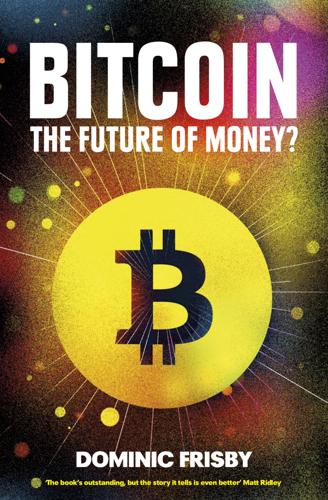
Bitcoin: The Future of Money?
by
Dominic Frisby
Published 1 Nov 2014
You could have programmable money and you could have programmable smart contracts that extended Bitcoin into something beyond just a money system – into a kind of a replacement for the current way the internet works. But he felt that there were a lot of concerns from scalability to security, so he purposefully neutered the scripting language of Bitcoin, so as to not enable this. We call it state and Turing completeness. ‘So, it’s been five years, we’ve learned a huge amount of lessons, there’s been a lot of overlay protocols, other attempts to increase the functionality of Bitcoin. What we did with Ethereum is we kind of unified a lot of the 2.0 actors and put them into a big bucket and we’re building a completely new block chain and we’re building a completely new scripting language that basically adds in those missing features.
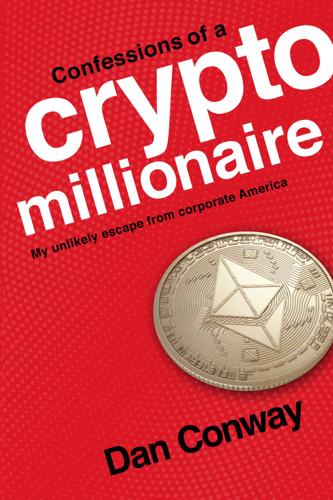
Confessions of a Crypto Millionaire: My Unlikely Escape From Corporate America
by
Dan Conway
Published 8 Sep 2019
Which reminds me of what Winston Churchill said about modern government: “Democracy is the worst form of government, except for all of the others.” The same could have been said of the modern firm. Until it wasn’t. While I was struggling to master the corporate world, which had always eluded me, a young genius named Vitalik Buterin was creating Ethereum. More on Vitalik later. Ethereum is a “Turing complete blockchain,” which means it can be programmed to do anything. Whereas Bitcoin has the functionality of a calculator and can transact digital money, Ethereum has the functionality of a computer and is a trustless—thus, supremely trustworthy —platform to transact any type of business. To understand this, you need to think of Ethereum not as a way to buy coffee with digital money but as a computer that can be accessed with the cryptocurrency, ether (ETH).
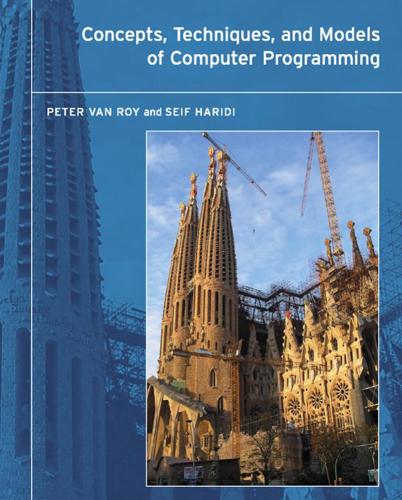
Concepts, Techniques, and Models of Computer Programming
by
Peter Van-Roy
and
Seif Haridi
Published 15 Feb 2004
Chapter 13 gives the semantics of this model and all its subsets. D.3 Concepts Let us now recapitulate the design methodology of the general model by starting with a simple base model and briefly explaining what new expressiveness each concept brings. All models are Turing complete, i.e., they are equivalent in computing power to a Turing machine. However, Turing completeness is only a small part of the story. The ease with which programs can be written or reasoned about differs greatly in these models. Increased expressiveness typically goes hand in hand with increased difficulty to reason about programs. D.3.1 Declarative models Strict functional model The simplest practical model is strict functional programming with values.
…
This model is defined in section 2.8.1. In this model there are no unbound variables; each new variable is immediately bound to a value. This model is close to the λ calculus, which contains just procedure definition and application and leaves out the conditional and pattern matching. The λ calculus is Turing complete but is much too cumbersome for practical programming. Sequential declarative model The sequential declarative model is defined in chapter 2. It contains all concepts in table D.1 up to and including procedure application, conditionals, and pattern matching. It extends the strict functional model by introducing dataflow variables.

Coders at Work
by
Peter Seibel
Published 22 Jun 2009
When I put in the calculation of prime numbers into the TeX manual I was not thinking of this as the way to use TeX. I was thinking, “Oh, by the way, look at this: dogs can stand on their hind legs and TeX can calculate prime numbers.” Seibel: But people use the fact that it's a Turing-complete programming language to do typesetting-related computations. If it wasn't Turing-complete they would be unable to do those things. Knuth: Yeah, that's right. I wrote a programming language for simulation in the '60s that I had to work hard to kill because it had a lot of users, but then when Simula came out I liked Simula better and I told people to stop using my SOL language.

On the Edge: The Art of Risking Everything
by
Nate Silver
Published 12 Aug 2024
But like an appliance on one of those late-night infomercials—it slices, it dices, it makes julienne fries!—the Ethereum blockchain can do a whole lot more than just record ETH transactions. In particular, it allows for the creation of so-called smart contracts. Ethereum contains a “built-in fully fledged Turing-complete programming language,” so the possibilities are almost unlimited. You could, for example, write an options contract—I have a right to buy one hundred ETH from you if the price rises above $2,500—and the blockchain would work to execute the contract automatically. In some ways, the origin story of Ethereum resembled that of a typical Silicon Valley startup, springing to life from a bright young immigrant founder willing to make a long-shot bet.
…
,” Investopedia, October 11, 2023, investopedia.com/terms/b/bitcoin-mining.asp. GO TO NOTE REFERENCE IN TEXT makes julienne fries: “Slices, Dices, and Makes Julienne Fries,” TV Tropes, tvtropes.org/pmwiki/pmwiki.php/Main/SlicesDicesAndMakesJulienneFries. GO TO NOTE REFERENCE IN TEXT “fully fledged Turing-complete”: Vitalik Buterin, “Ethereum: A Next-Generation Smart Contract and Decentralized Application Platform,” 2014, https://blockchainlab.com/pdf/Ethereum_white_paper-a_next_generation_smart_contract_and_decentralized_application_platform-vitalik-buterin.pdf. GO TO NOTE REFERENCE IN TEXT an award-winning programmer: “IOI 2012: Results,” International Olympiad in Informatics Statistics, stats.ioinformatics.org/results/2012.

Augmented: Life in the Smart Lane
by
Brett King
Published 5 May 2016
He is a recognised authority in the mechanical engineering of non-humanoid robotics. Q. Eliot, you’ve talked previously about the core drivers in designing robots for the future and you’ve made a case that robots don’t need to look like humans to be effective. Can you tell me about your thesis behind this? A. In a nutshell, there is no Turing complete mechanical system. Atoms do not generalise in the same way that bits generalise. Looking at the history of computers is misleading. A key central innovation (the general-purpose CPU) could be arbitrarily reprogrammed to any other data manipulation task, as the movement of data bits was pretty close to free.

This Will Make You Smarter: 150 New Scientific Concepts to Improve Your Thinking
by
John Brockman
Published 14 Feb 2012
As you begin to form these and other concepts, the chaos on the screen gradually becomes more comprehensible. Developing concepts that carve nature at its joints is the first crucial step toward understanding, not only in the Game of Life but in science and in ordinary life as well. At a more advanced level, we discover that the Game of Life is Turing complete. That is, it’s possible to build a pattern that acts like a Universal Turing Machine (a computer that can simulate any other computer). Thus, any computable function could be implemented in the Game of Life—including perhaps a function that describes a universe like the one we inhabit. It’s also possible to build a universal constructor in the Game of Life, a pattern that can build many types of complex objects, including copies of itself.
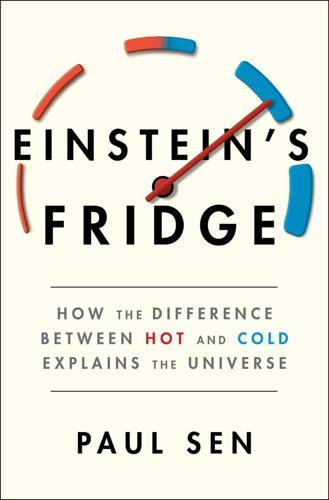
Einstein's Fridge: How the Difference Between Hot and Cold Explains the Universe
by
Paul Sen
Published 16 Mar 2021
Submitted in late 1951, this paper was nothing less than an attempt to propose a mechanism by which embryos are shaped as they develop in the womb. Turing considered it his best work since his 1936 paper laying down the foundations of computing. By any measure it’s a work of extraordinary scientific imagination. For in it, Turing completely recast the second law of thermodynamics. Here it is perhaps important to remember that since the discovery in the mid-nineteenth century that entropy always increases, the second law has often had strongly negative connotations. The inevitable dissipation of energy, such as the flow of heat from hot to cold, became seen as synonymous with decay and death.

Chokepoint Capitalism
by
Rebecca Giblin
and
Cory Doctorow
Published 26 Sep 2022
The research and development that goes into improving a particle accelerator’s computer ends up benefiting all kinds of computing, bequeathing improvements in power, reliability, and cost to the processors in your car, HVAC system, and mobile phone. Digital technology gets faster and better and cheaper because everything we do to solve problems in one corner of the digital world makes things better everywhere else. But this universality can also be a curse. We know how to make universal computers—computers that are Turing complete, a concept named for the British wartime computer science pioneer Alan Turing—but we don’t know how to make almost-universal computers. It’s easy to make a train track that only supports one kind of railcar: it’s impossible to make a phone that only runs apps from one app store. When you encounter a digital product that has a restriction like this—a video service that won’t let you access its streams without logging in or using its app, an ebook that only plays on one kind of reader or an ebook reader than only displays one kind of ebook, a gaming console that only plays games that were approved by its manufacturer, or even a coffee-pod machine that rejects third-party pods—you’re not dealing with a computer that can’t do what you’ve asked of it.

When Einstein Walked With Gödel: Excursions to the Edge of Thought
by
Jim Holt
Published 14 May 2018
Von Neumann and Turing were virtual opposites in character and appearance: the older man a portly, well-attired, and clubbable sybarite who relished wielding power and influence; the younger one a shy, slovenly, dreamy ascetic (and homosexual), fond of intellectual puzzles, mechanical tinkering, and long-distance running. Yet the two shared a knack for getting to the logical essence of things. After Turing completed his Ph.D. in 1938, von Neumann offered him a salaried job as his assistant at the institute, but with war seemingly imminent Turing decided to return to England instead. “The history of digital computing,” Dyson writes in his 2012 book, Turing’s Cathedral, “can be divided into an Old Testament whose prophets, led by Leibniz, supplied the logic, and a New Testament whose prophets, led by von Neumann, built the machines.

More Everything Forever: AI Overlords, Space Empires, and Silicon Valley's Crusade to Control the Fate of Humanity
by
Adam Becker
Published 14 Jun 2025
Jack Copeland, “The Church-Turing Thesis,” Stanford Encyclopedia of Philosophy (Spring 2024), https://plato.stanford.edu/archives/spr2024/entries/church-turing/. 104 An analogy for the software engineers: even if the computers we have now were powerful enough, implementing a human-level AI on them might be like trying to write a website back end in Brainfuck or some other obfuscated language—technically possible, because it’s Turing complete, but not a great way to approach the problem. 105 Chalmers, “The Singularity,” 11. 106 Rodney Brooks, “Predictions Scorecard, 2024 January 01,” RodneyBrooks.com (blog), January 1, 2024, https://rodneybrooks.com/predictions-scorecard-2024-january-01/. 107 Kurzweil, Singularity Is Near, 29. 108 W.

The Age of Cryptocurrency: How Bitcoin and Digital Money Are Challenging the Global Economic Order
by
Paul Vigna
and
Michael J. Casey
Published 27 Jan 2015
All the secondary protocols being built upon it were similarly narrow. He was essentially saying it was like DOS, before Windows was created. What if he built an entirely independent protocol and blockchain that could sustain any kind of application written in any programming language, one that was, as developers say, “Turing complete”? What if it could support any decentralized service—currency-trading systems, smart contracts, shareholder registrations, voting systems, DApps, DACs, DAOs, whatever—and let developers construct as pretty an interface as they felt their market needed? The solution he came up with quickly took the cryptocurrency world by storm: a completely redesigned, fully versatile, decentralized blockchain that could function as an open platform on which all manner of contracts and decentralized applications could be installed.
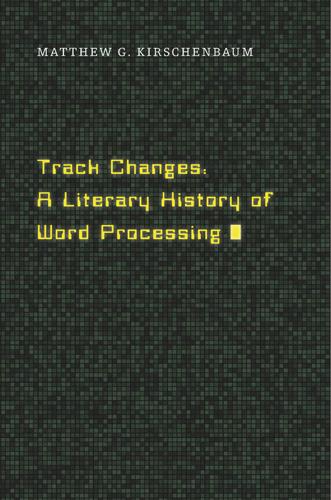
Track Changes
by
Matthew G. Kirschenbaum
Published 1 May 2016
When we ran it, conversation ceased and flakes of plaster would drift down from the ceiling. The room thrummed. We purchased earplugs in bulk.”45 Hyperbole, of course, but it conveys the essence of the experience. Berezin remains particularly proud of the fact that despite its name the Data Secretary was not “just” a hardwired word processor. It was a real computer, Turing-complete as the jargon goes: “The only thing that made it a word processor was the program.”46 Its integrated circuits could, in theory, be repurposed for other applications, albeit not necessarily efficiently. By September 1971 Redactron was ready to begin shipping. Next came advertising and promotion, and this presented its own challenges; it was a “very new idea,” as Berezin recalls.47 She enlisted the aid of Roslyn Willett, an old friend who now ran a public relations agency—noteworthy in itself in an era when such agencies were dominated by (mad) men.
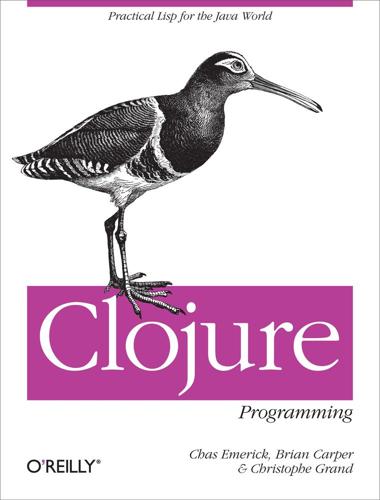
Clojure Programming
by
Chas Emerick
,
Brian Carper
and
Christophe Grand
Published 15 Aug 2011
It should be clear that some languages offer more powerful means of abstraction than others. Imagine for a moment a programming language without loops. Such a language might be usable, but unrolling all loops by hand would be incredibly tedious. Similarly, a language without functions might be able to do anything any other Turing-complete language can do, but code would have to be repeated over and over. In short, when a language lacks proper means of abstraction, the result is boilerplate and repetition, both signs of fundamental weaknesses in that language. Macros are powerful because they give you a way to define entirely new levels of abstraction within the language itself.
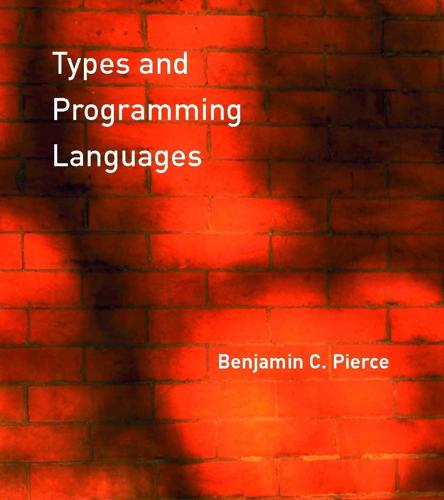
Types and Programming Languages
by
Benjamin C. Pierce
Published 4 Jan 2002
That is, we want to introduce typing rules for variables, abstractions, and applications that (a) maintain type safety—i.e., satisfy the type preservation and progress theorems, 8.3.2 and 8.3.3—and (b) are not too conservative—i.e., they should assign types to most of the programs we actually care about writing. Of course, since the pure lambda-calculus is Turing complete, there is no hope of giving an exact type analysis for these primitives. For example, there is no way of reliably determining whether a program like if <long and tricky computation> then true else (λx.x) yields a boolean or a function without actually running the long and tricky computation and seeing whether it yields true or false.

Engineering Security
by
Peter Gutmann
For example if you’d like to get your blog posts rated highly then you can use similar types of tricks to have them submit themselves to social news site Digg [647]. Another proof-ofconcept used LaTeX to implement a virus that infects other LaTeX documents, 49 Security issues are actually a secondary problem with these Turing machines, with the primary one being that any Turing-complete domain-specific language starts out being a hammer and then at some point ends up being used as a screwdriver, pocket knife, spanner, car jack, lint remover, bandsaw and, eventually, a nail. User Education, and Why it Doesn’t Work 199 although this could easily have been extended to perform standard malware functions like stealing data or downloading and installing binaries to add assorted supplemental functionality to the operating environment [648][649].
…
For example the Norwegian banks use a weird inside-out design in which a centralised system controlled by the Norwegian Banks’ Payment and Clearing Centre generates a private key on behalf of the user, sends the public portion out to the user’s bank to be turned into a certificate, and then performs all signing operations in the centralised infrastructure with the user having no control over, or even access to, their own keys and certificates [114][115]. The user’s interaction with the banking system is the standard password/PIN used by any other bank, although in this case with special twists that make them more vulnerable to attack, as discussed in “Banking Passwords” on page 606. In other 147 Whether certificate paths are Turing-complete is an open problem. Certificate Chains 671 words this has all the overhead and complexity of a PKI while providing a service no different from what any other bank achieves without any PKI components. Combine this with the fact that using the whole system requires the use of the horribly vulnerability-prone Java environment in the browser and it’s no surprise that attackers have already figured out how to bypass it and perform unauthorised withdrawals of funds from customer accounts [116].

Rationality: From AI to Zombies
by
Eliezer Yudkowsky
Published 11 Mar 2015
There is no soul anywhere that need fear true annihilation; God will prevent it. What if you build your own simulated universe? The classic example of a simulated universe is Conway’s Game of Life. I do urge you to investigate Life if you’ve never played it—it’s important for comprehending the notion of “physical law.” Conway’s Life has been proven Turing-complete, so it would be possible to build a sentient being in the Life universe, although it might be rather fragile and awkward. Other cellular automata would make it simpler. Could you, by creating a simulated universe, escape the reach of God? Could you simulate a Game of Life containing sentient entities, and torture the beings therein?
…
And it’s not likely that anyone will defy the Khan; if they did, someone would strike them with a sword, and the sword would disrupt their organs and they would die, and that would be the end of that. So the victims die, screaming, and no one helps them; that is the answer to the what-if question. Could the victims be completely innocent? Why not, in the what-if world? If you look at the rules for Conway’s Game of Life (which is Turing-complete, so we can embed arbitrary computable physics in there), then the rules are really very simple. Cells with three living neighbors stay alive; cells with two neighbors stay the same; all other cells die. There isn’t anything in there about innocent people not being horribly tortured for indefinite periods.
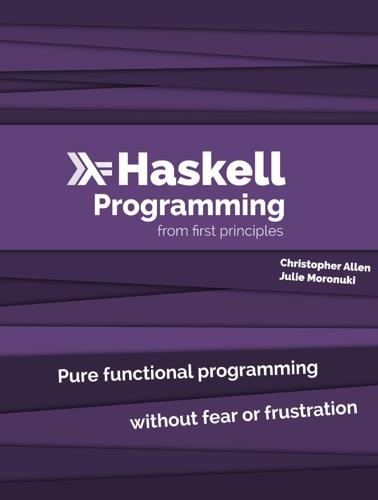
Haskell Programming: From First Principles
by
Christopher Allen
and
Julie Moronuki
Published 1 Jan 2015
Recursion is a means of expressing code that must take an indefinite number of steps to return a result. But the lambda calculus does not appear on the surface to have any means of recursion, because of the anonymity of expressions. How do you call something without a name? Being able to write recursive functions, though, is essential to Turing completeness. We use a combinator – known as the Y combinator or fixed-point combinator – to write recursive functions in the lambda calculus. Haskell has native recursion ability based on the same principle as the Y combinator. It is important to have a solid understanding of the behavior of recursive functions.

The Stack: On Software and Sovereignty
by
Benjamin H. Bratton
Published 19 Feb 2016
The machinic image is qualified by many little sinkholes between the symbolic, the imaginary, and the real, and at a global scale of billions of Users, the interfacial image is also partially a function of sheer machinic quantity. With the comparatively instantaneous adoption of mobile devices (a Turing complete processor + camera + homing tether + telephonic voice relay), we have seen an explosion in the absolute volume of mechanical images of and in the world, dwarfing the total sum produced before the mobile phone appeared in our hands. Unlike images of the painting-photographic-cinematic era, these images do not pass into an archive only after their practical life is passed; rather, through various Apps, images are produced through the medium of the archival database itself, socialized through the archive, and assigned searchable metadata through the archive.